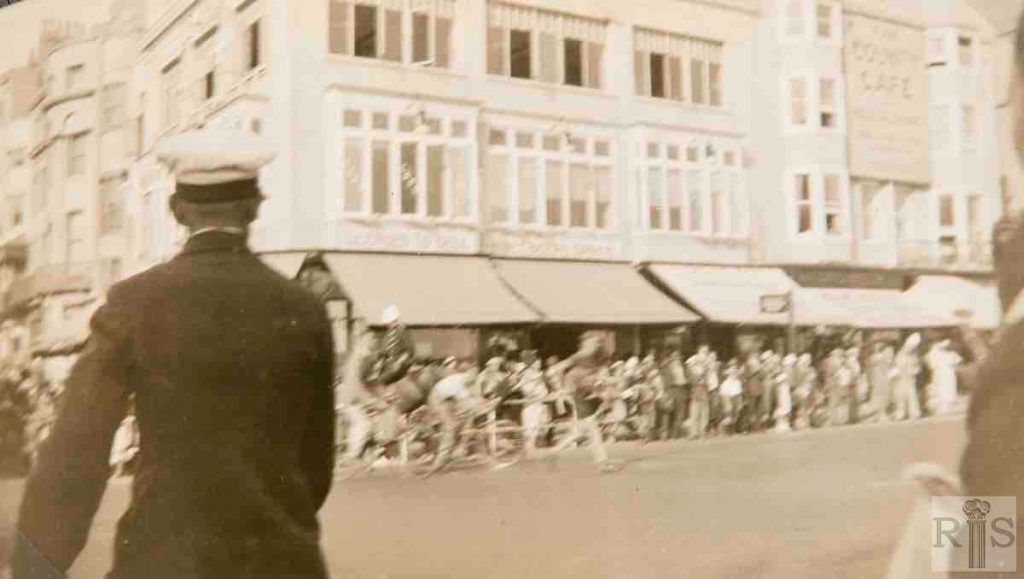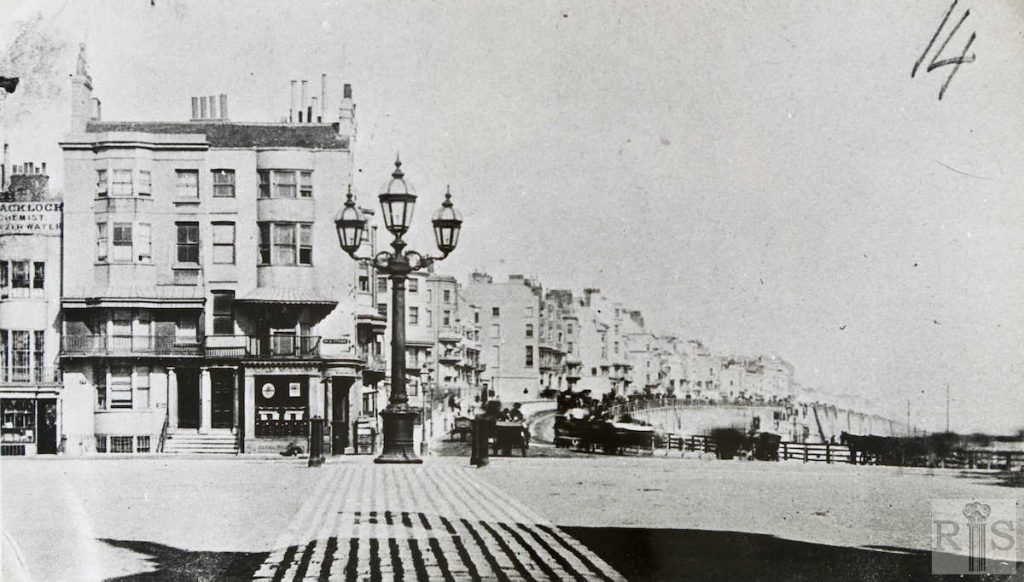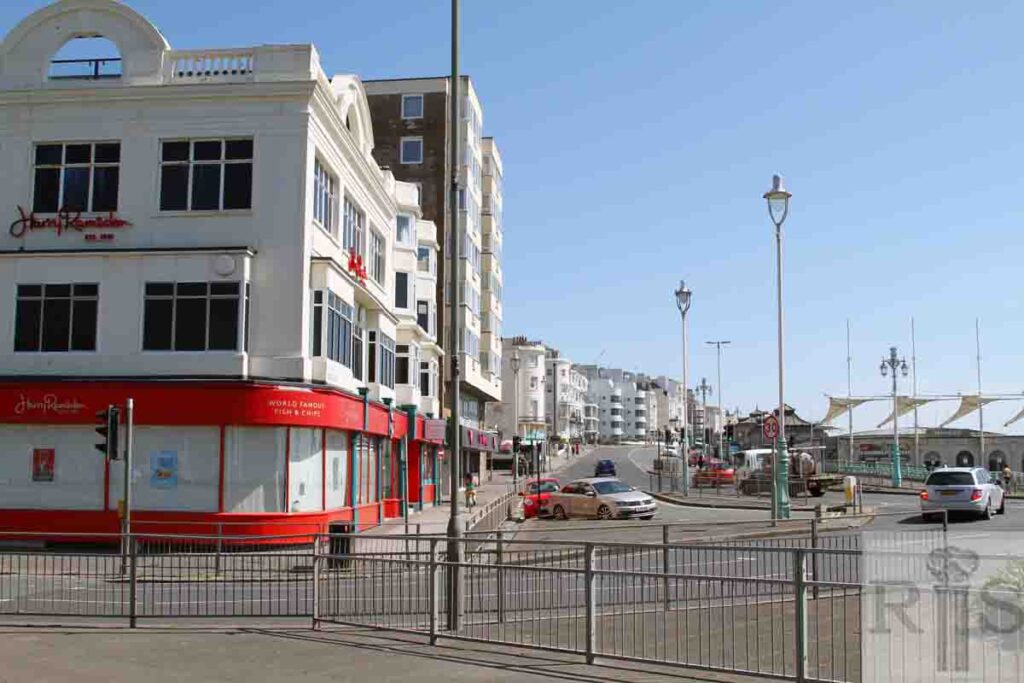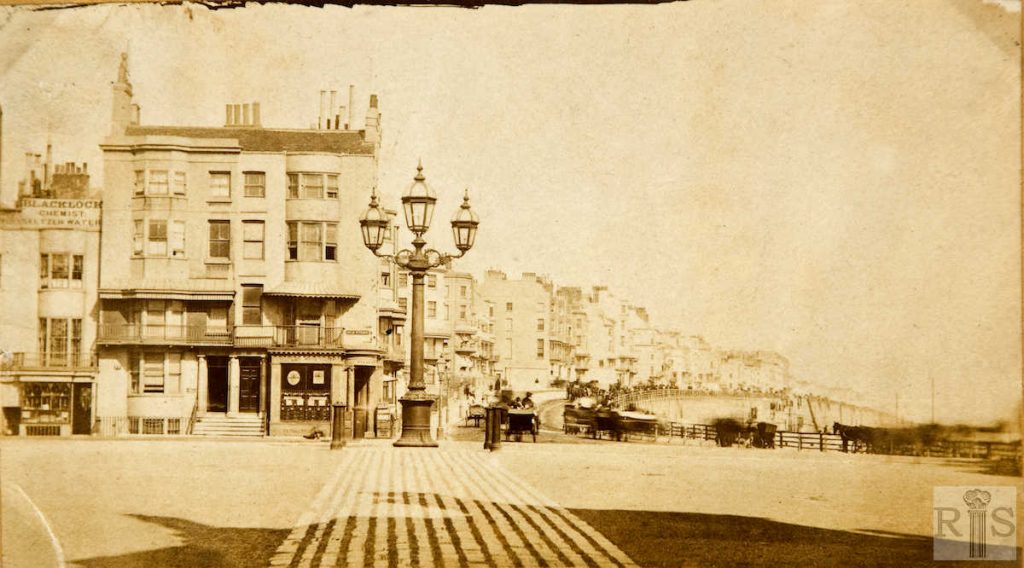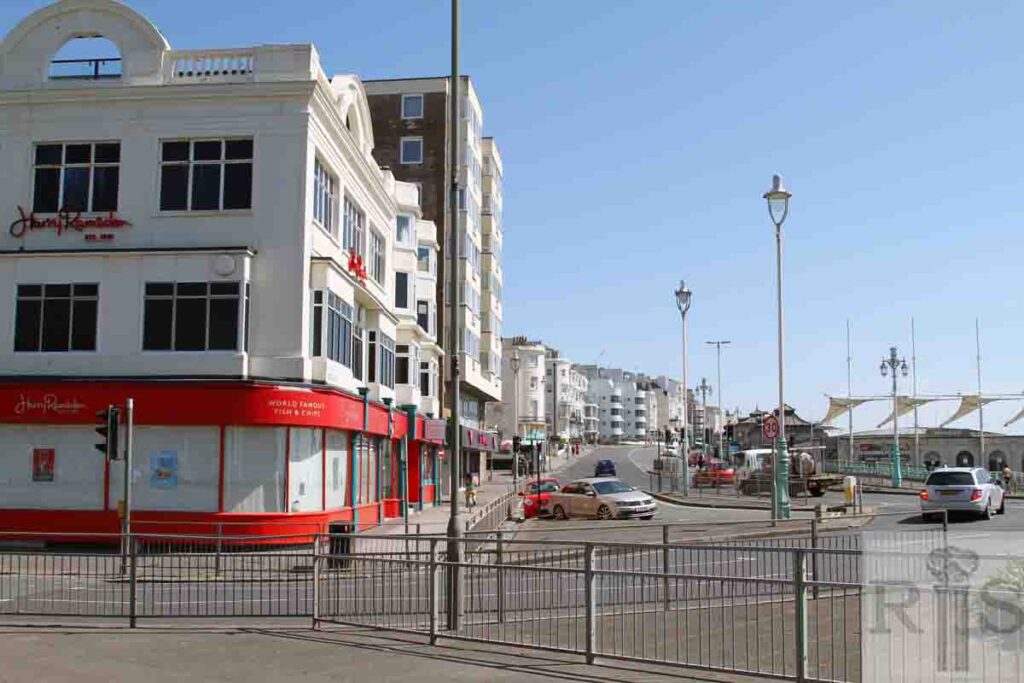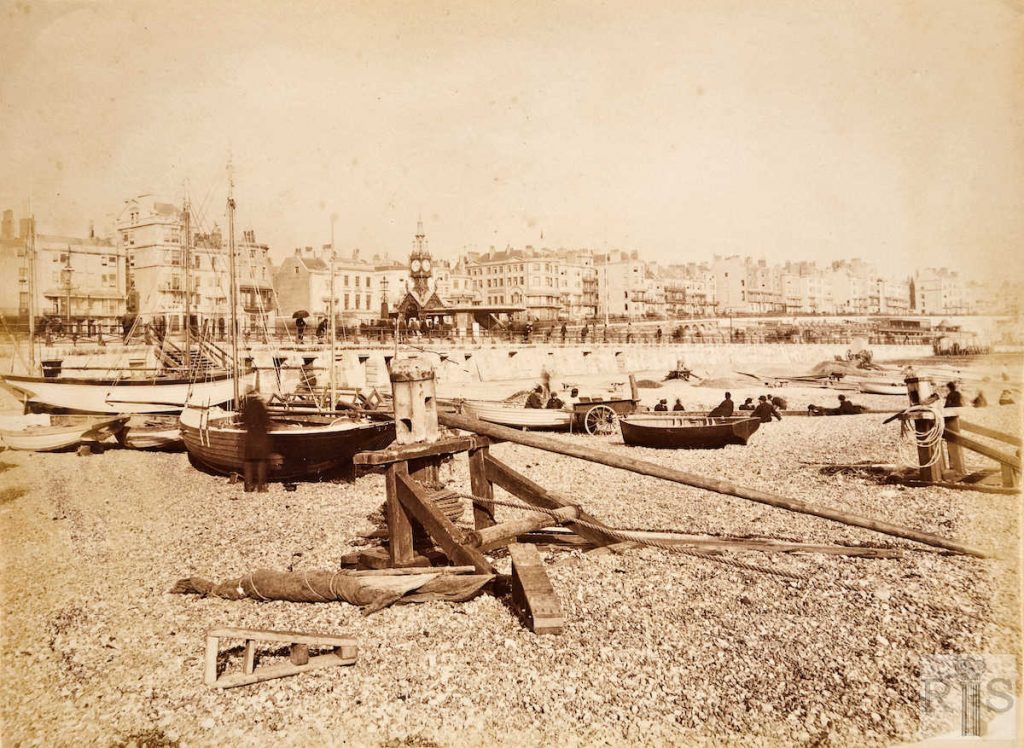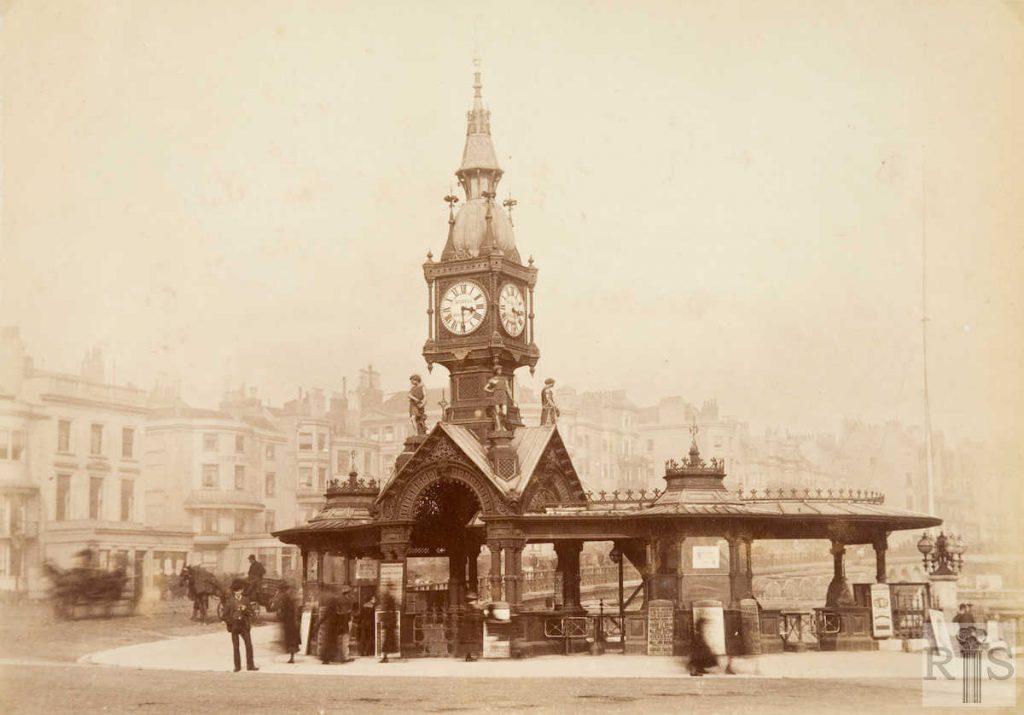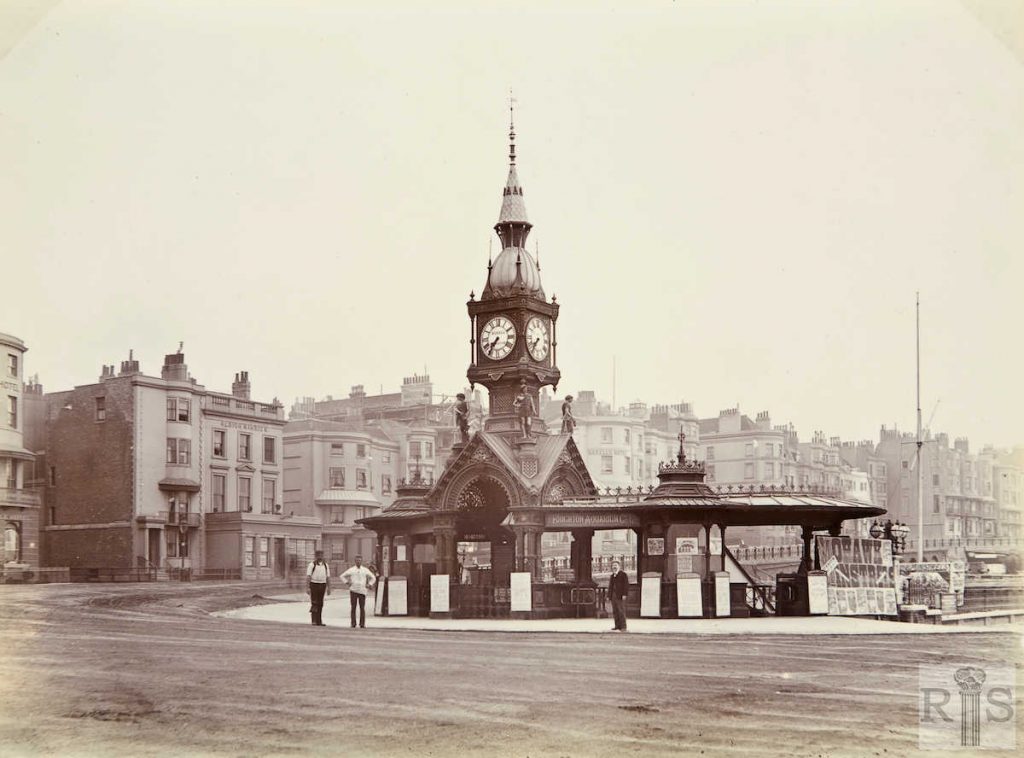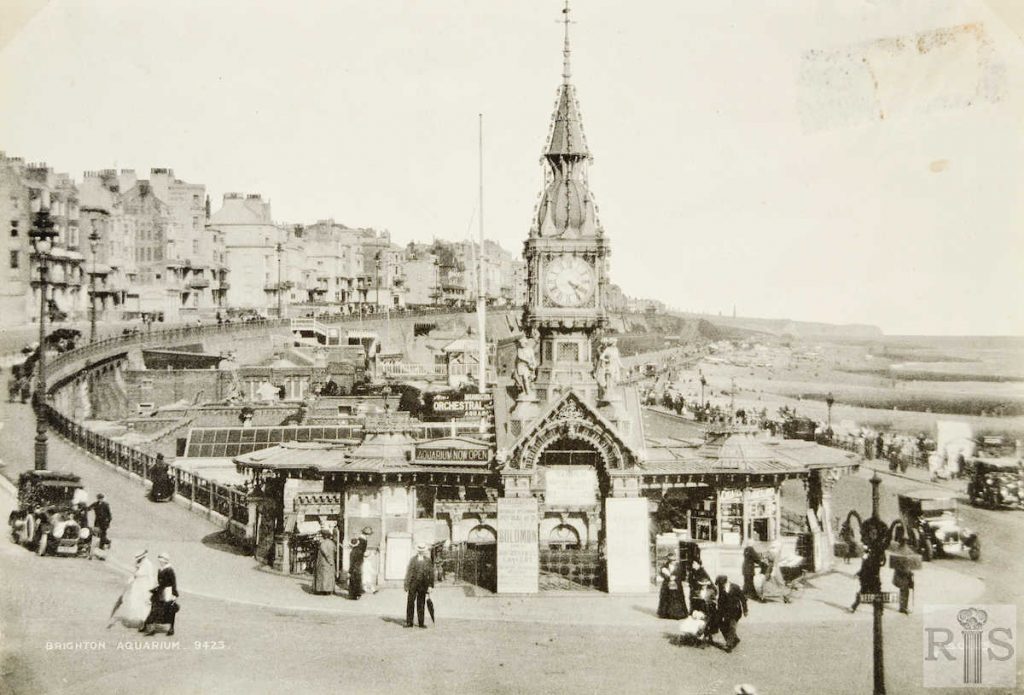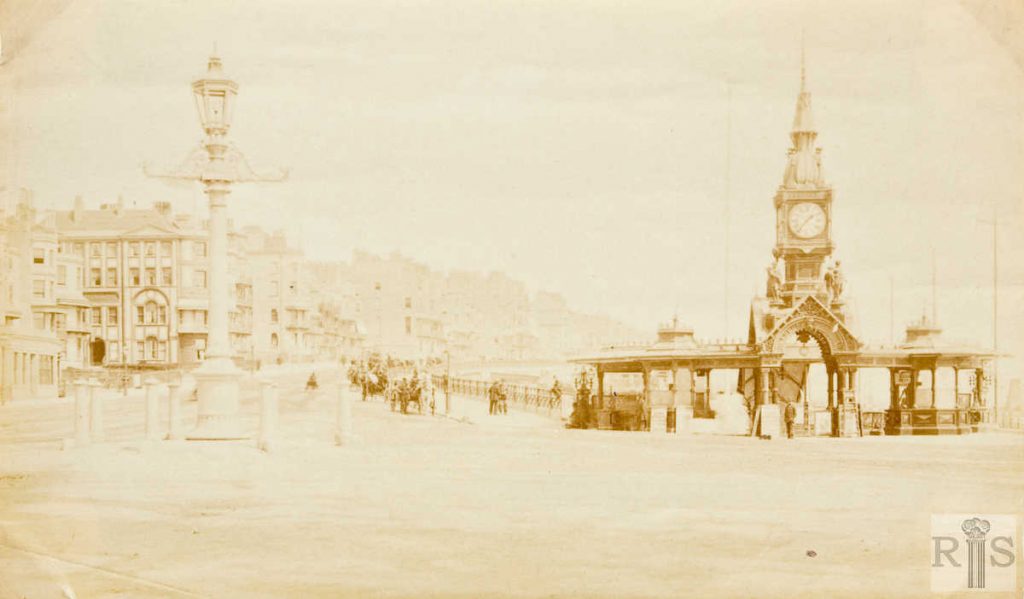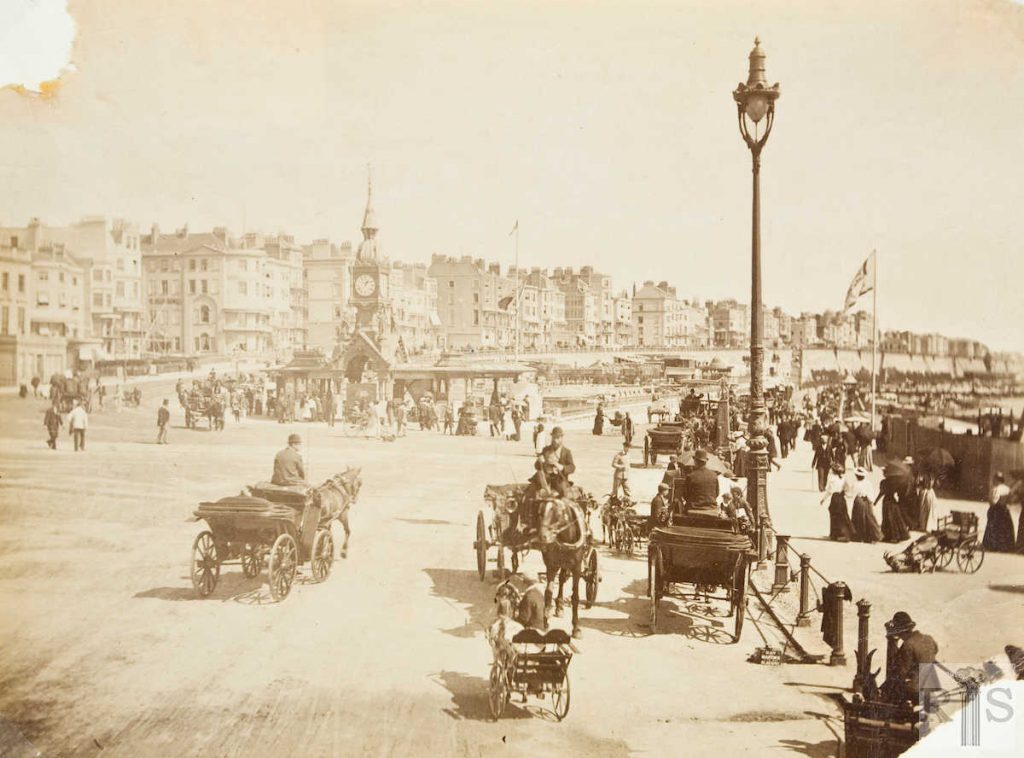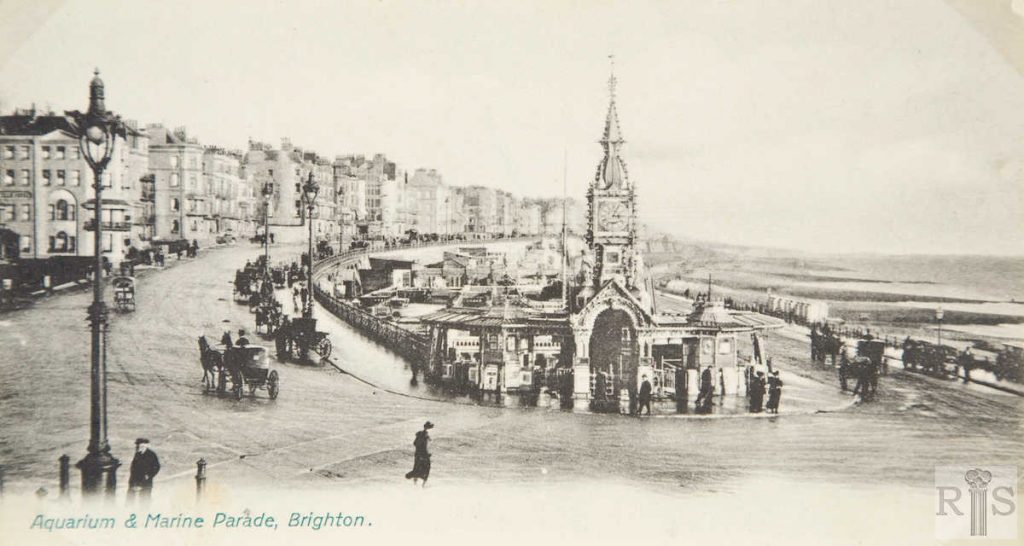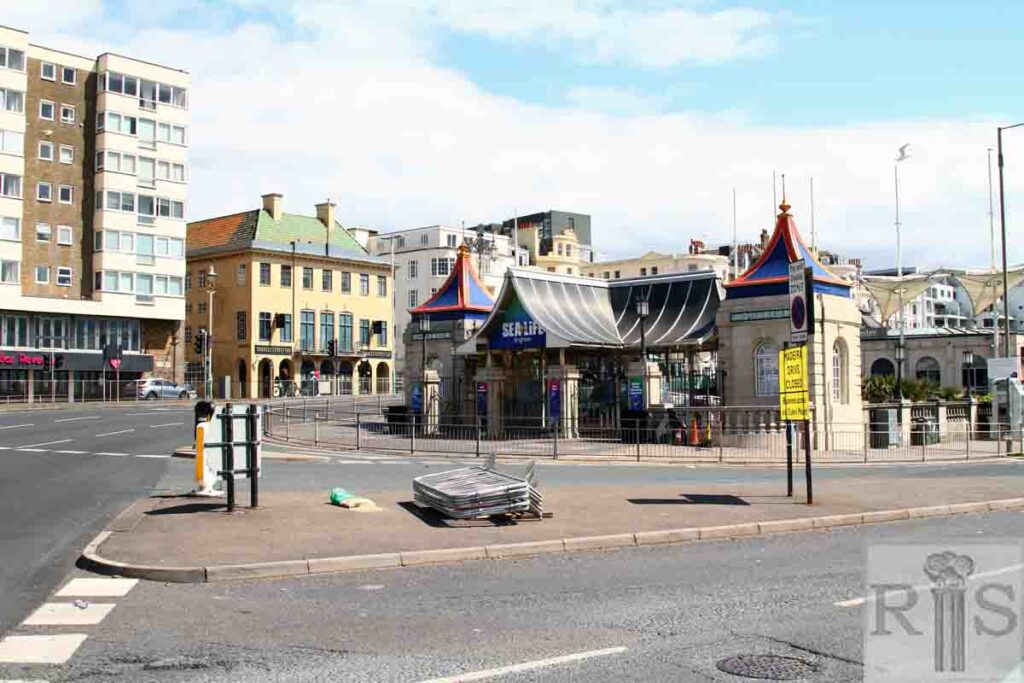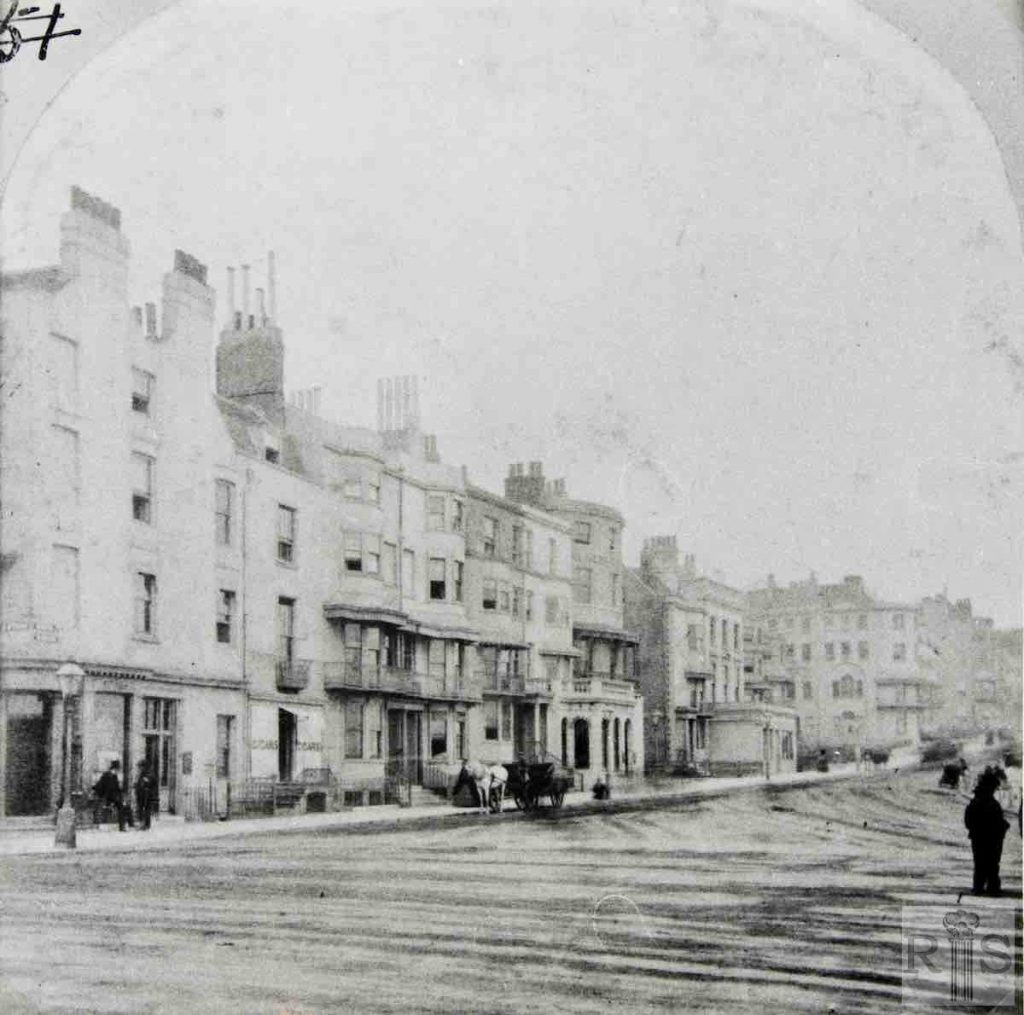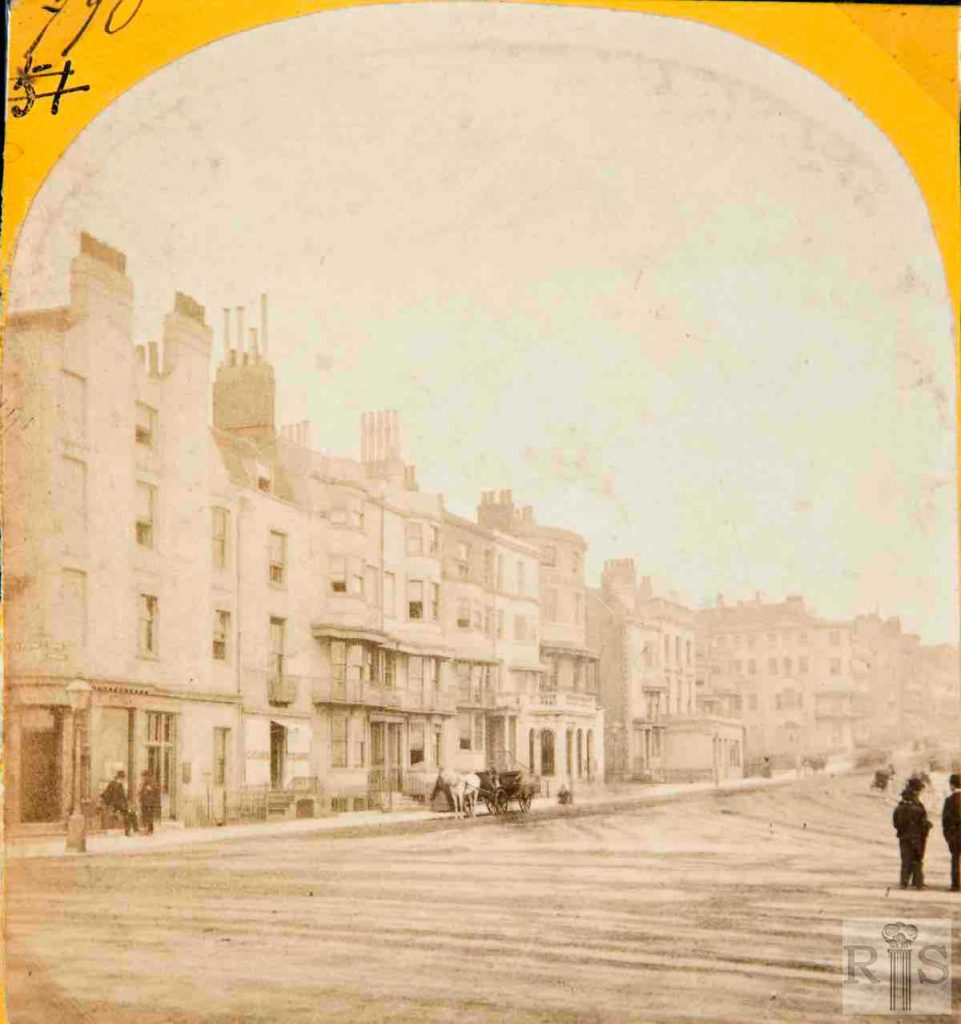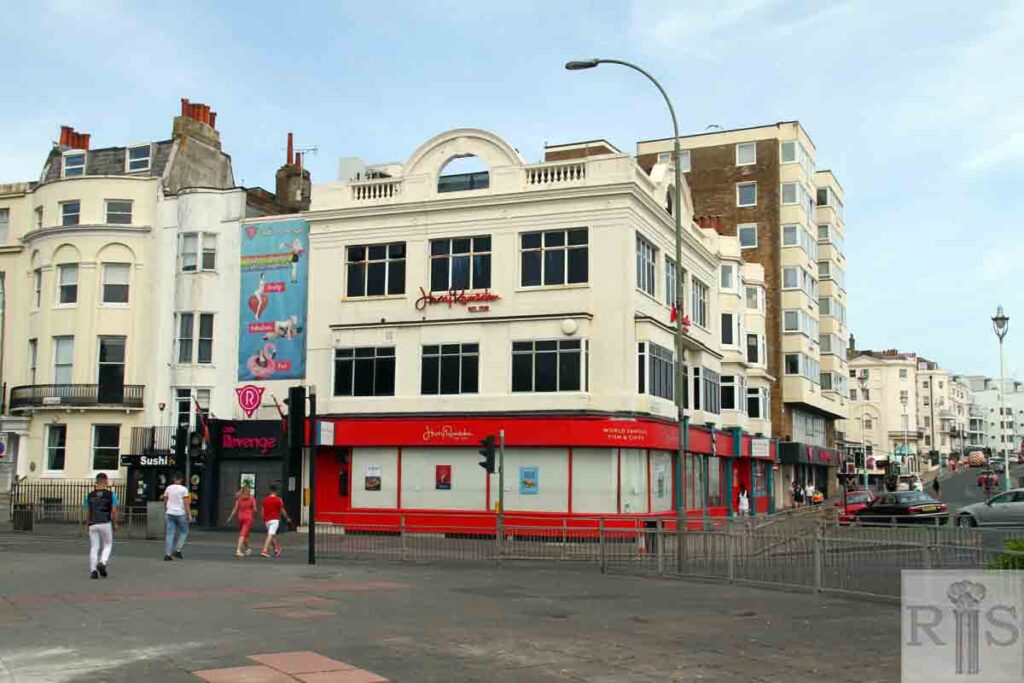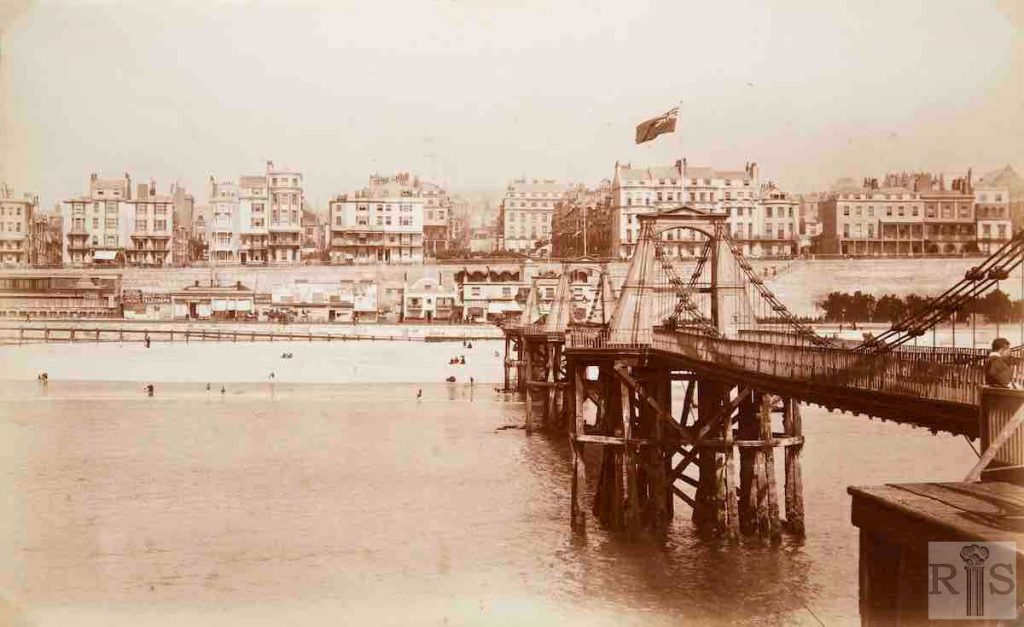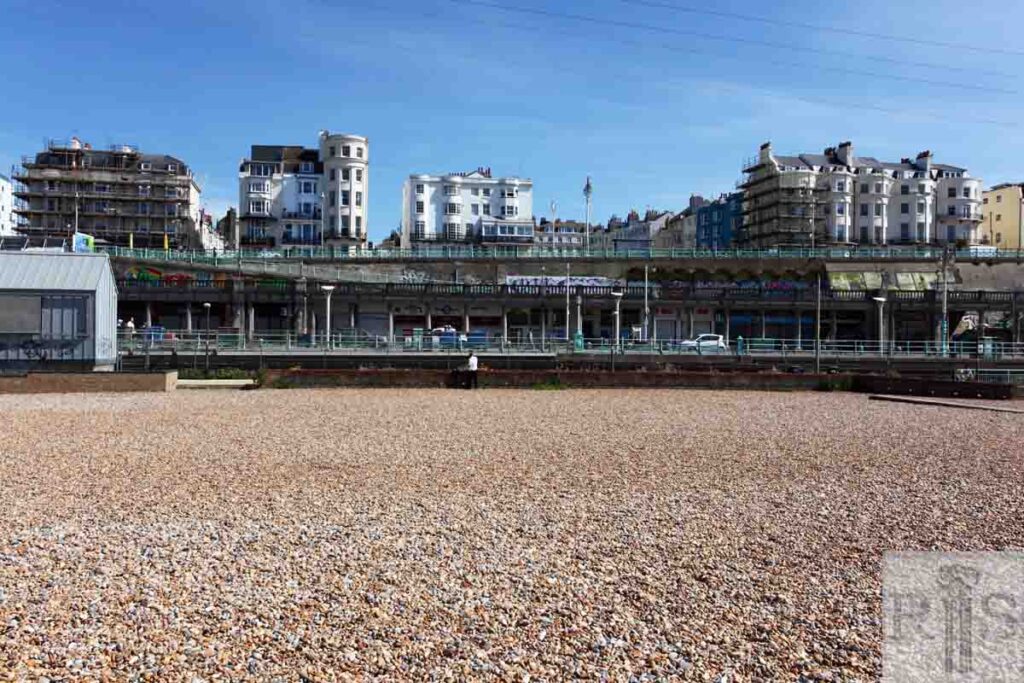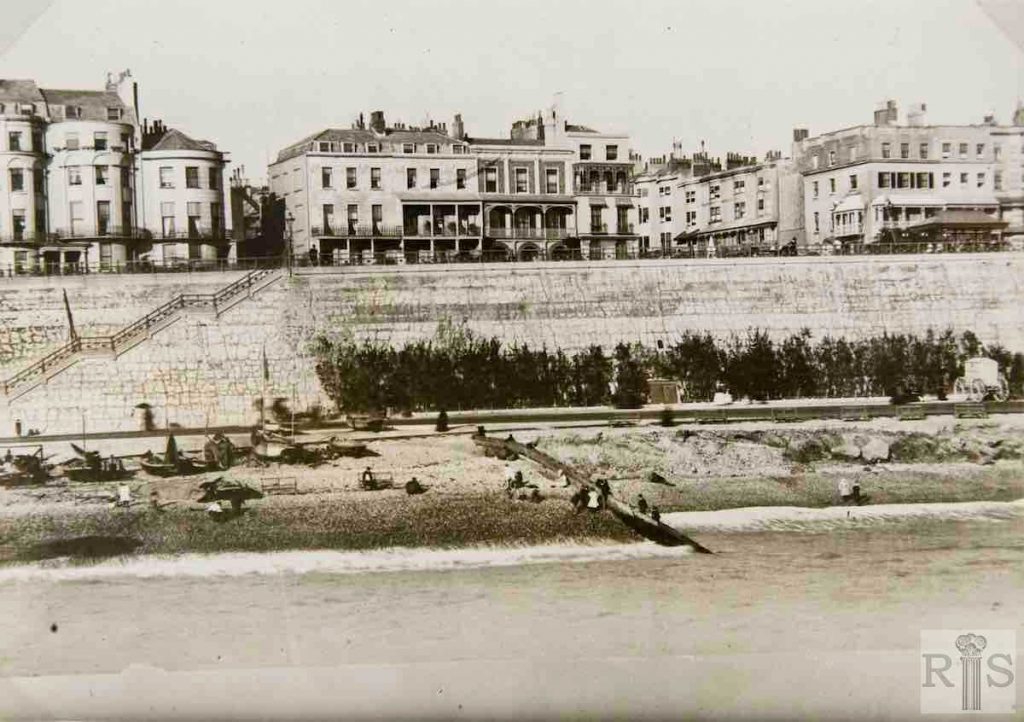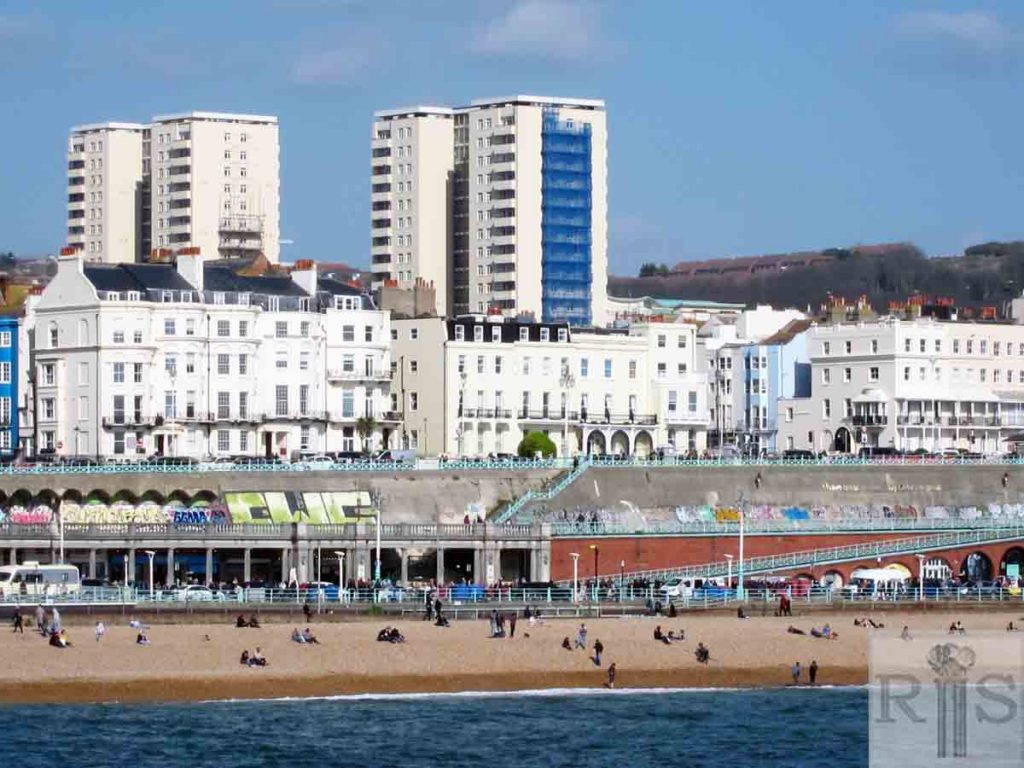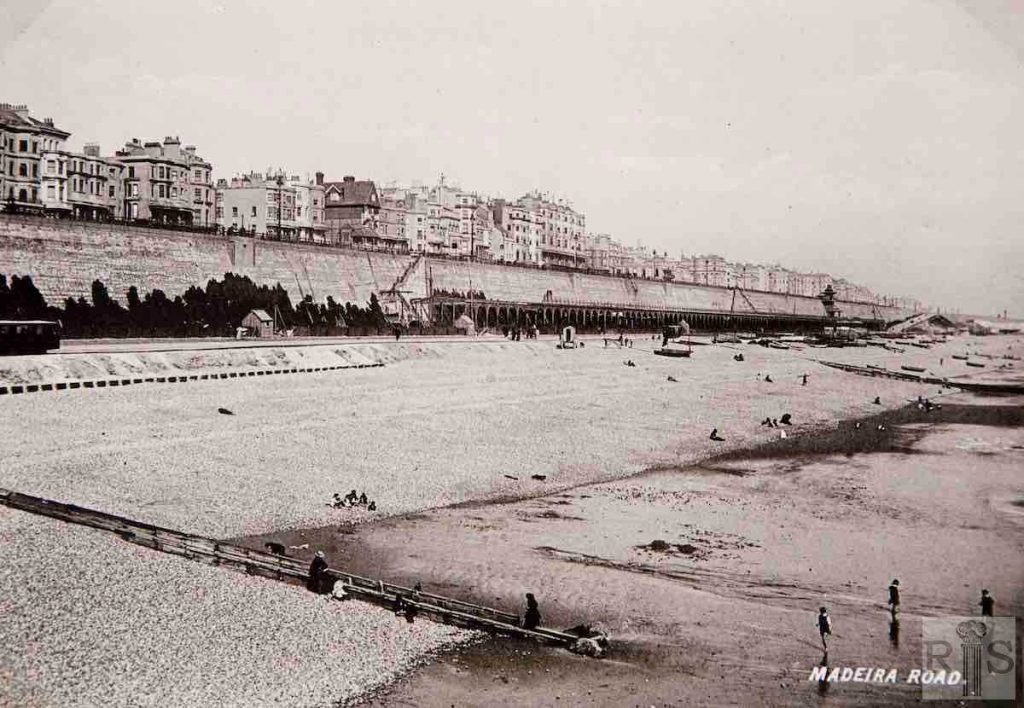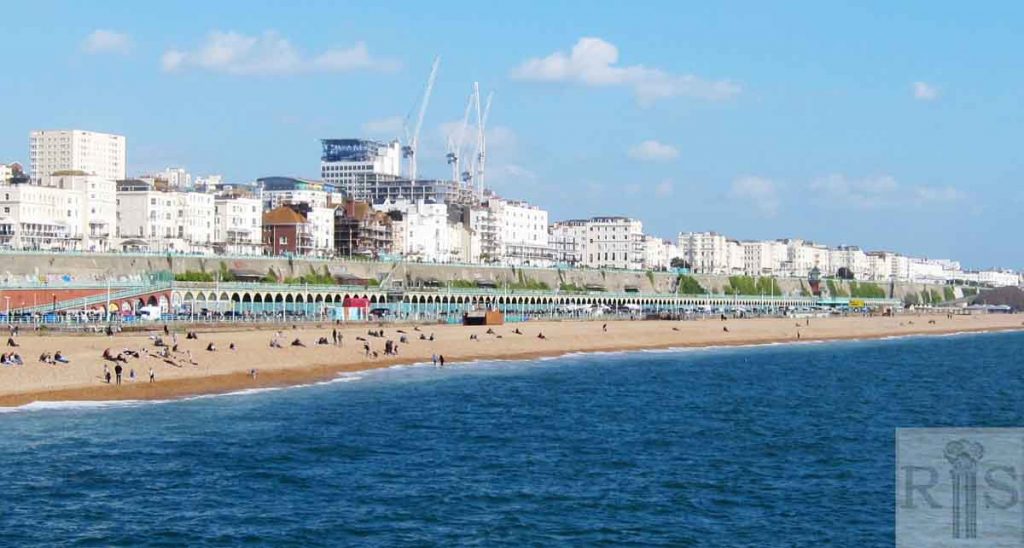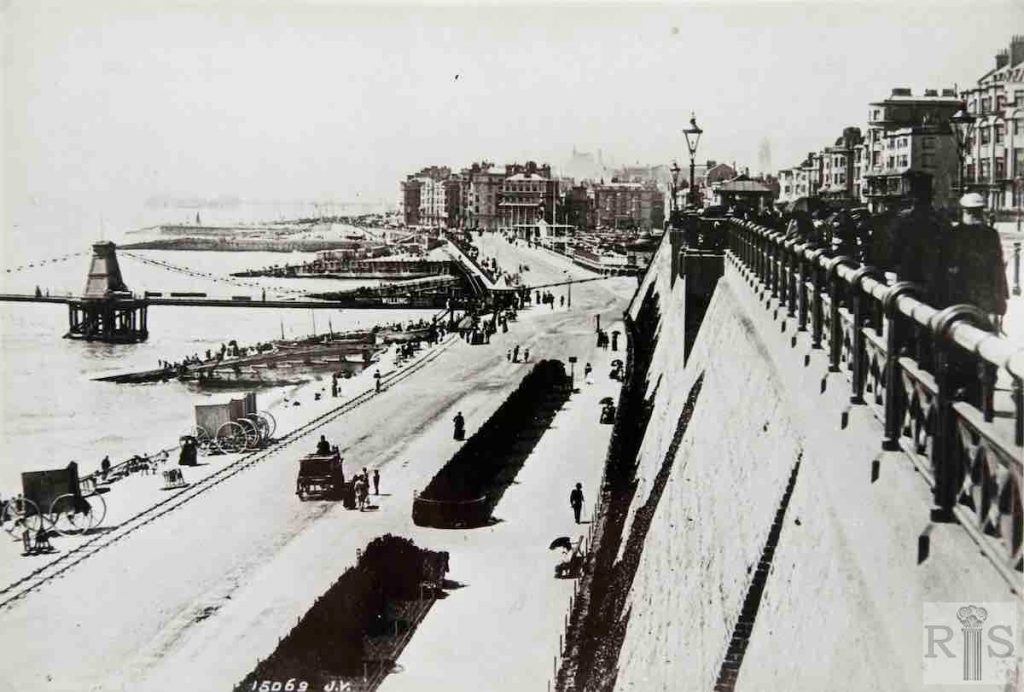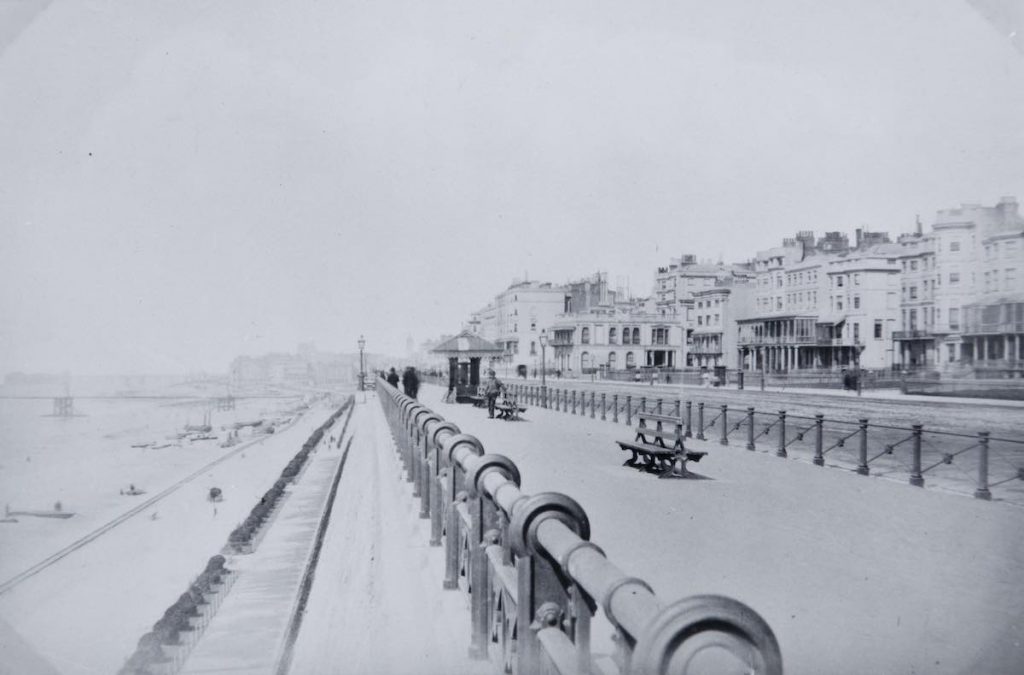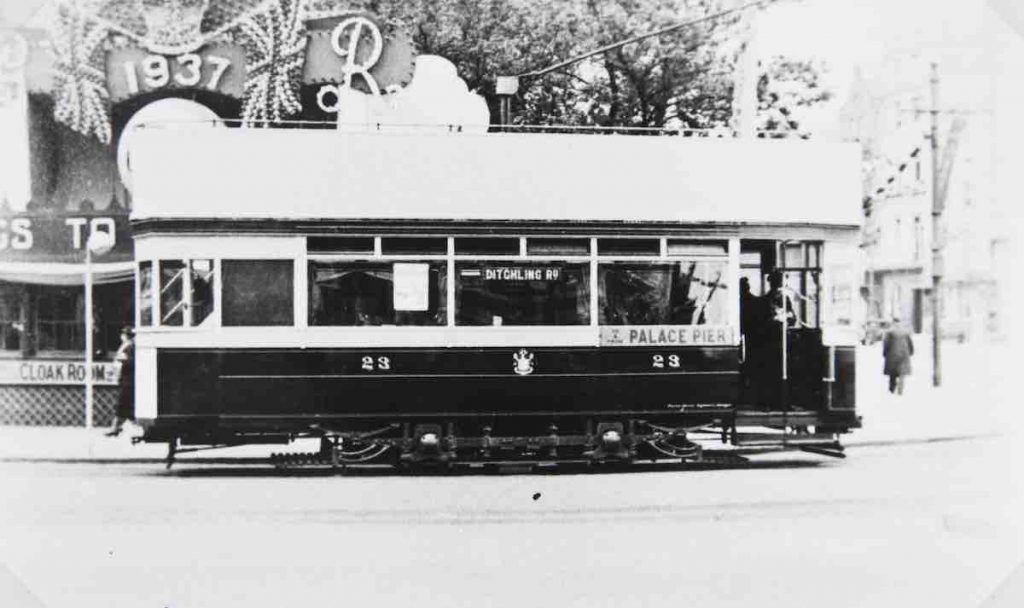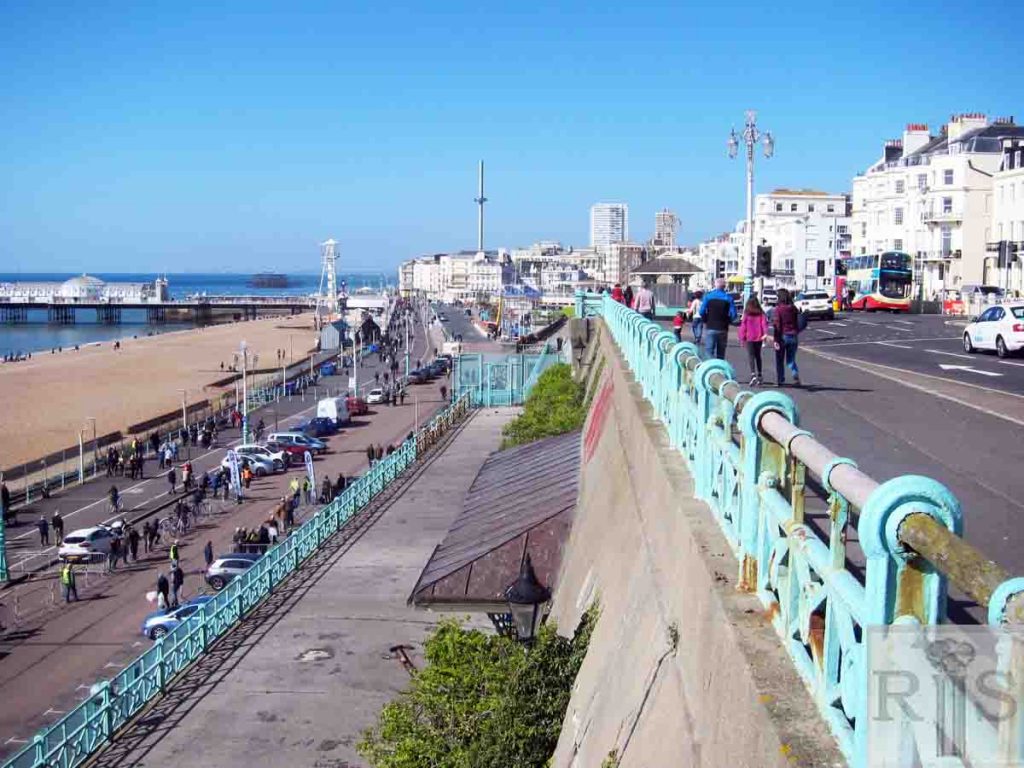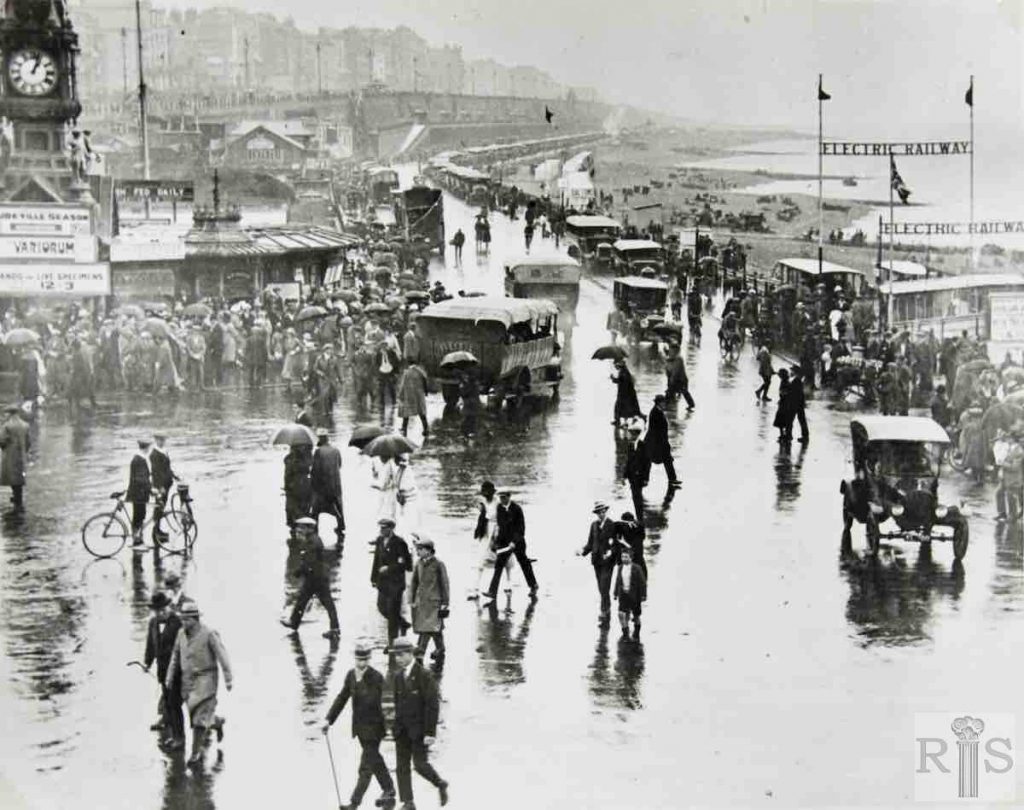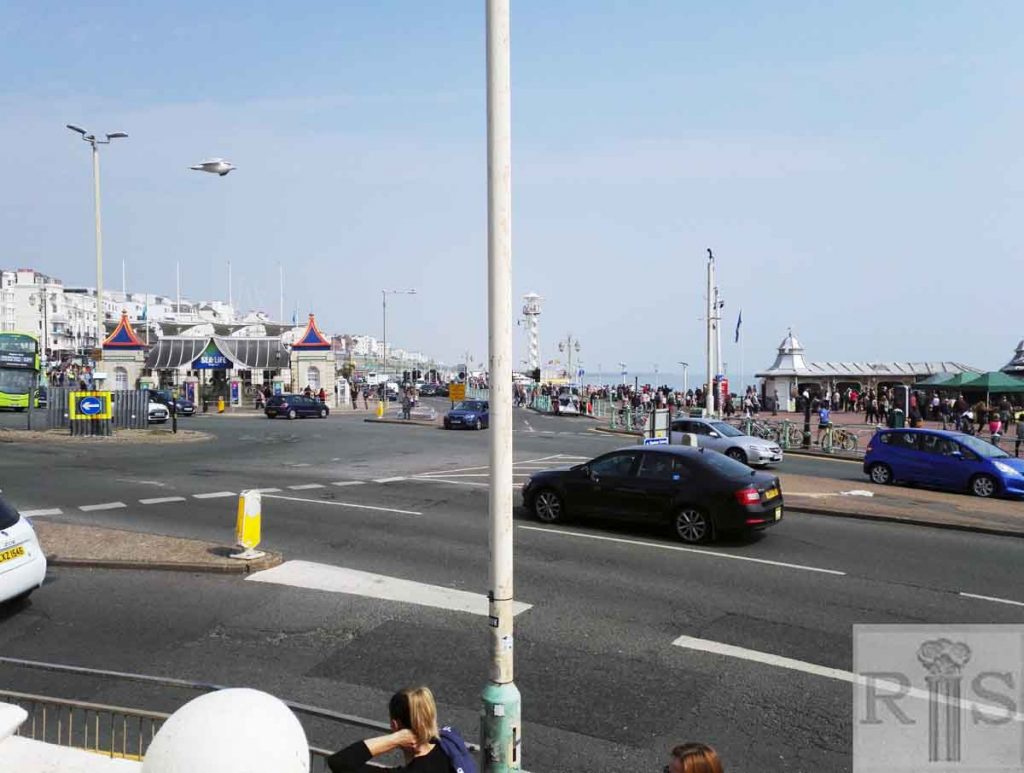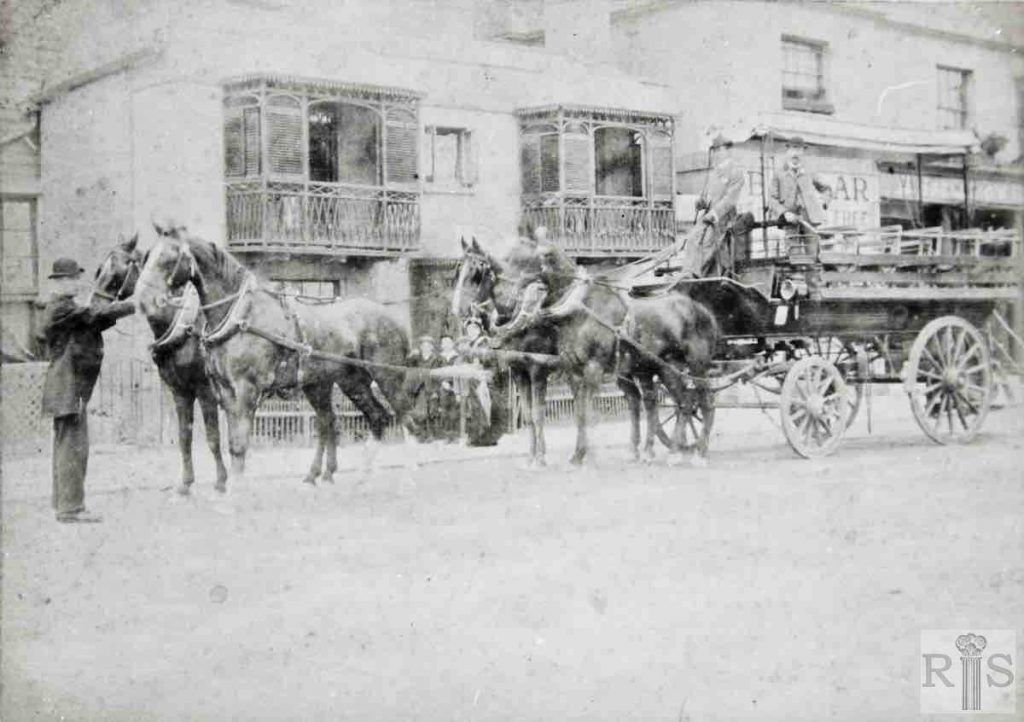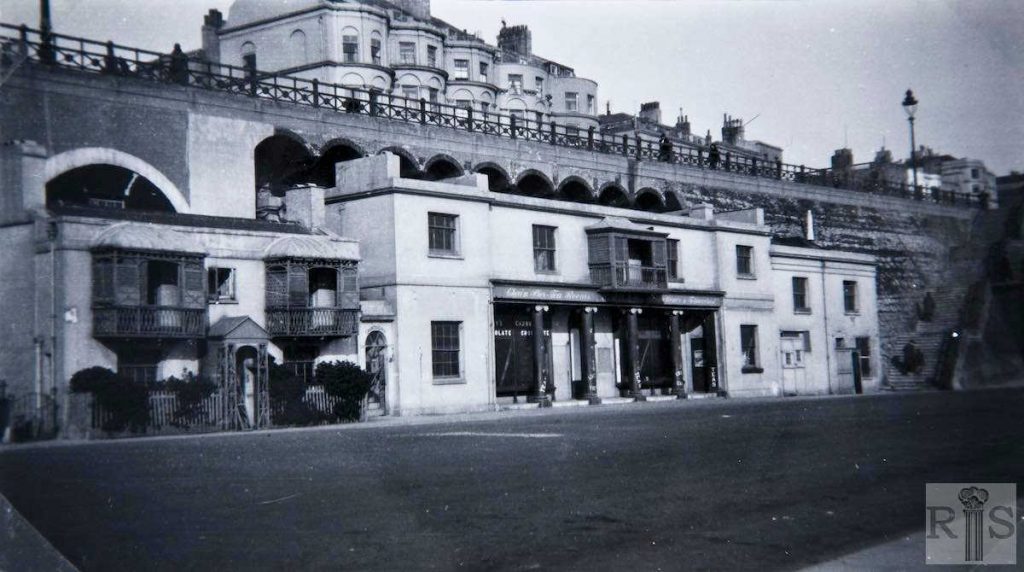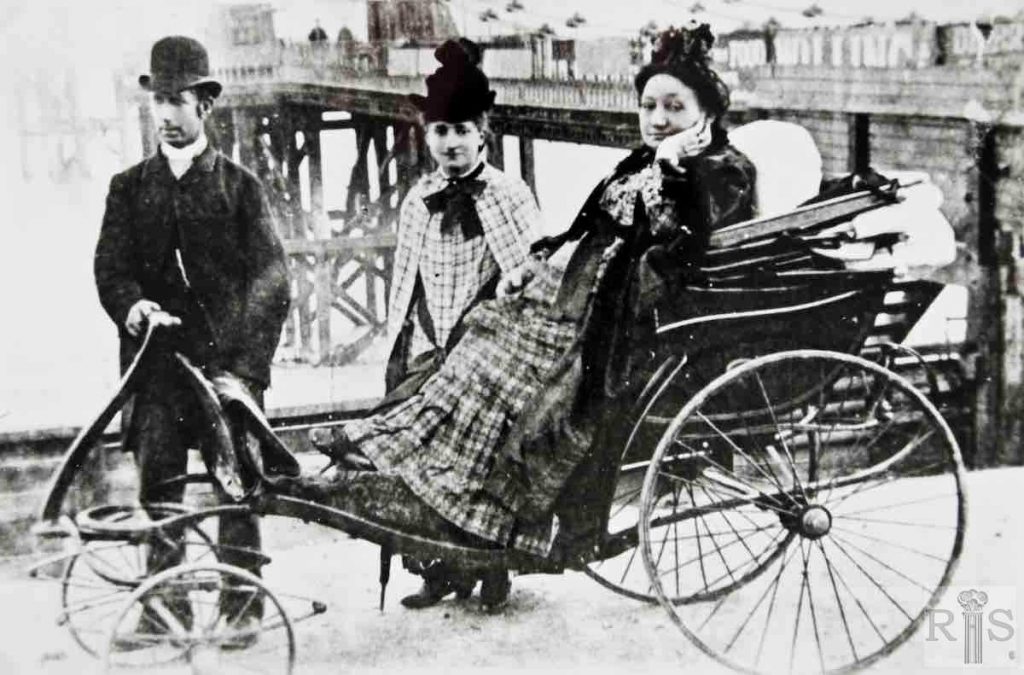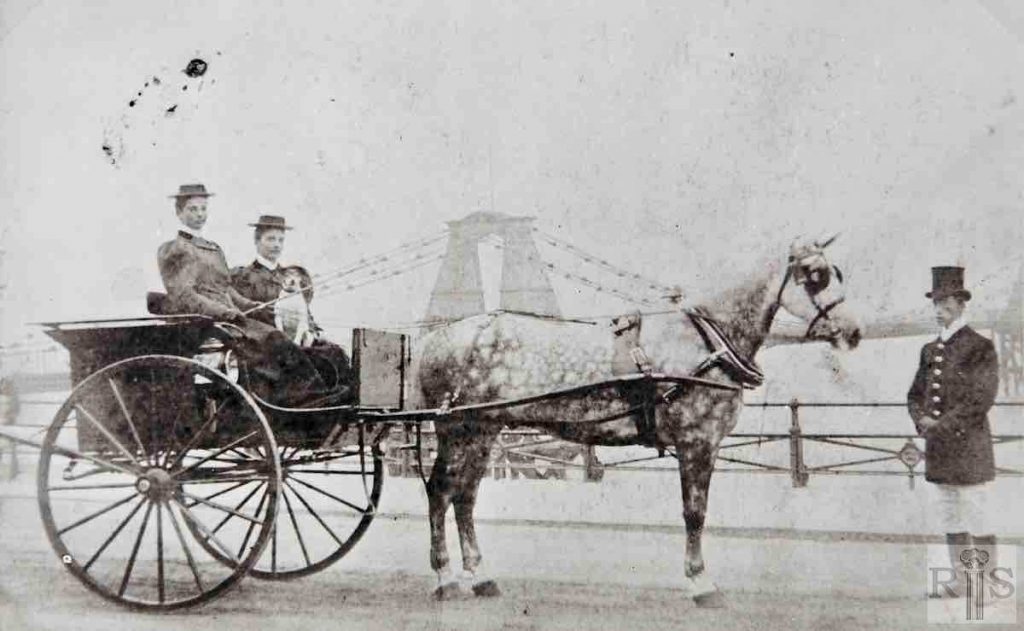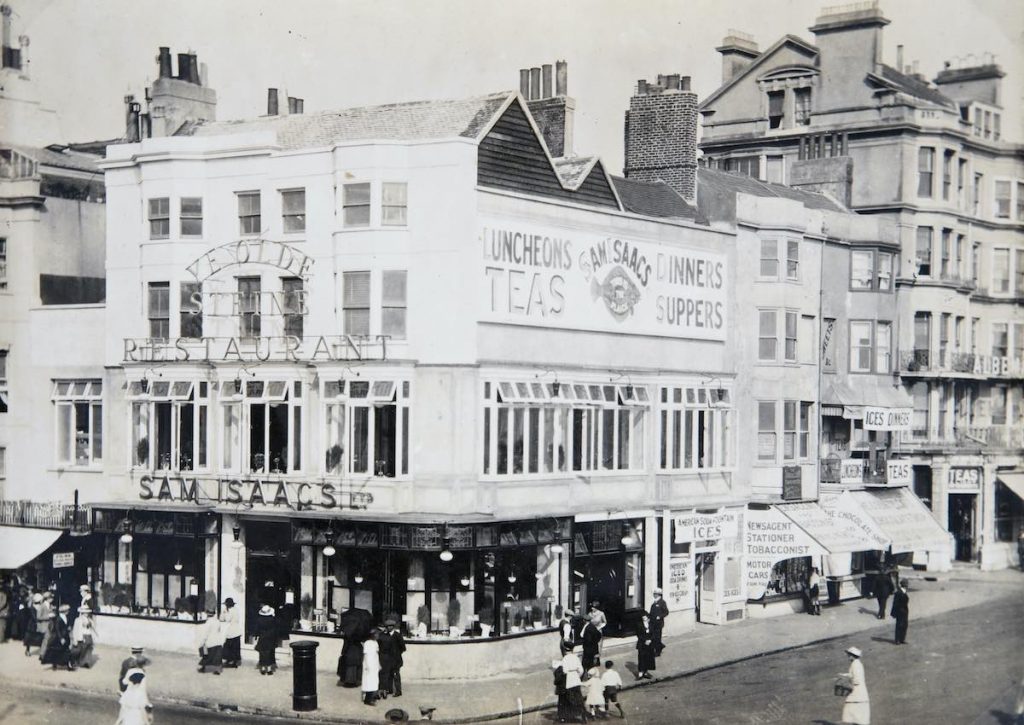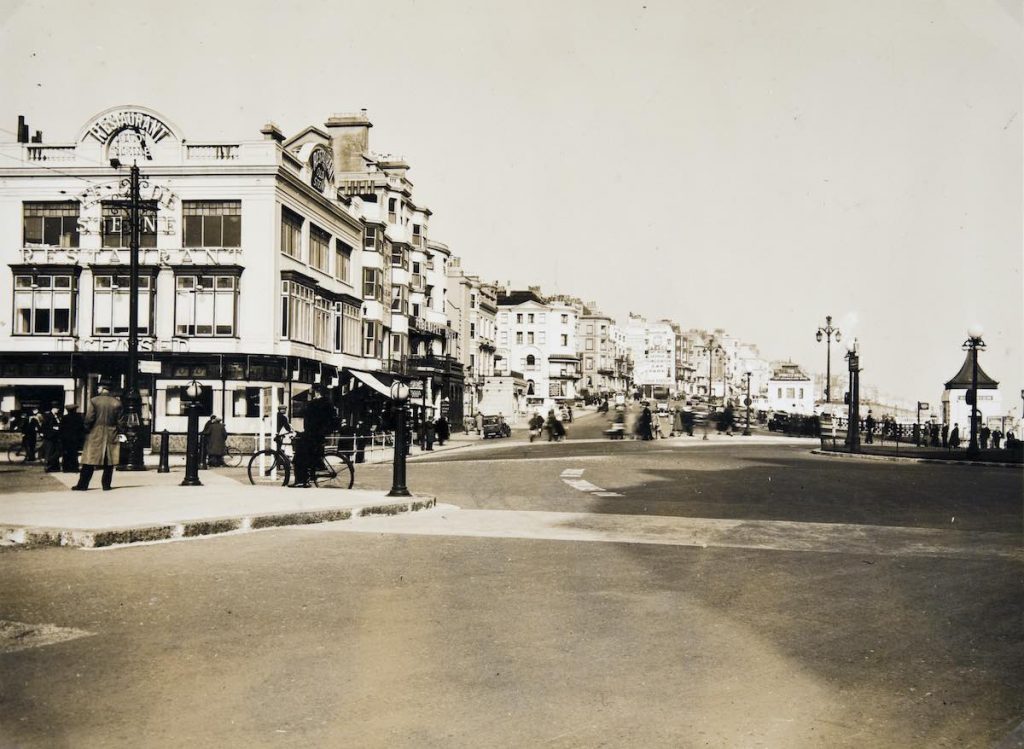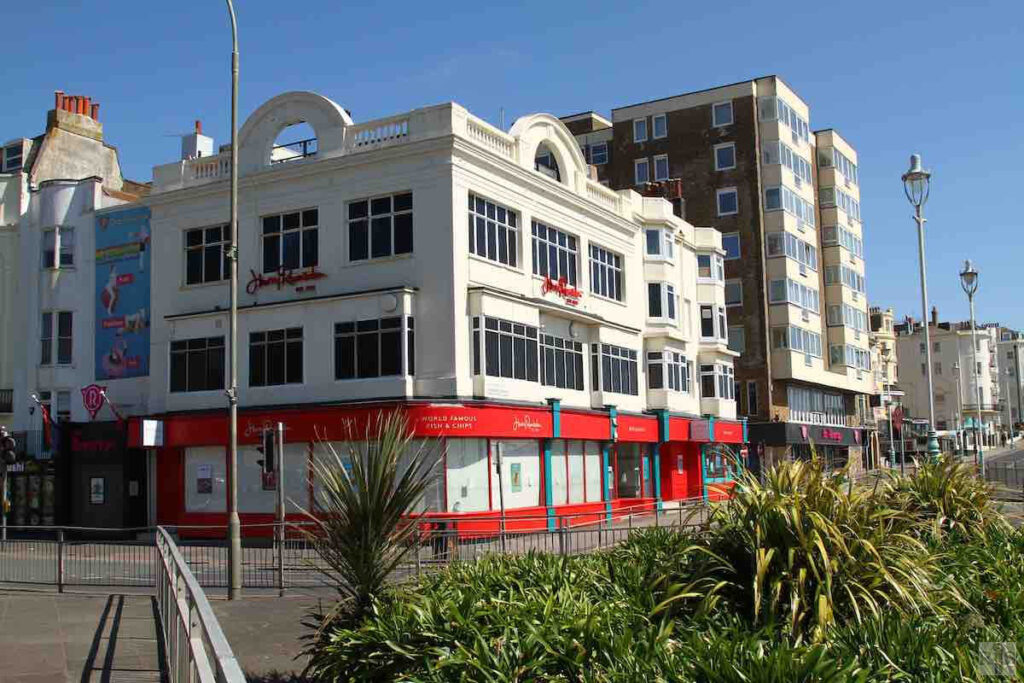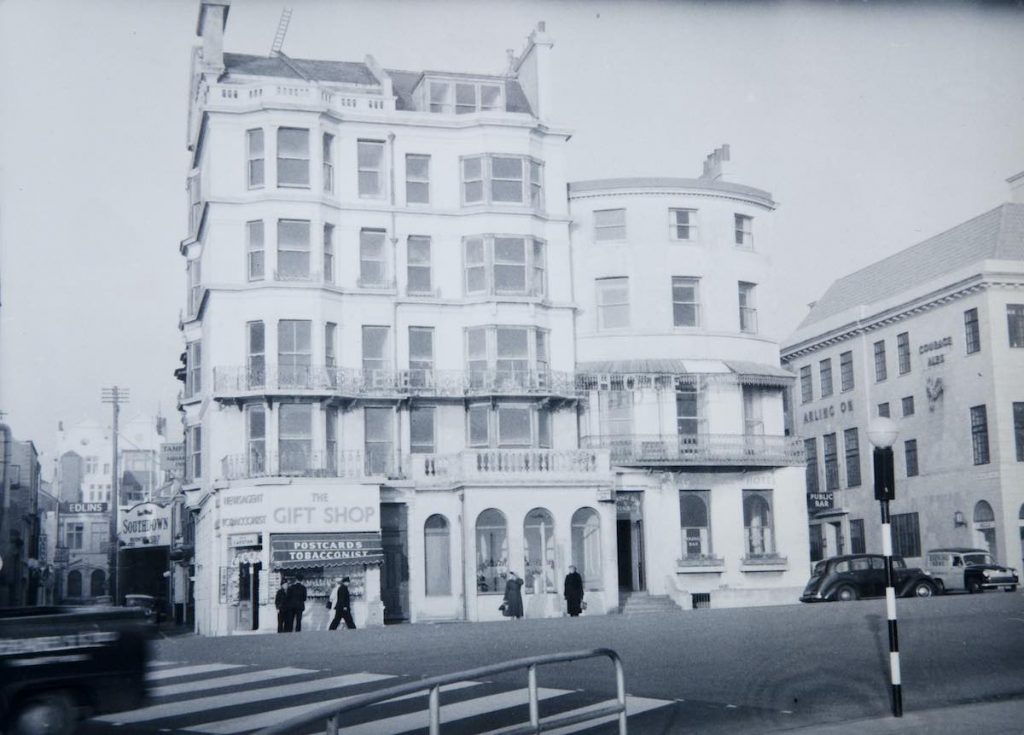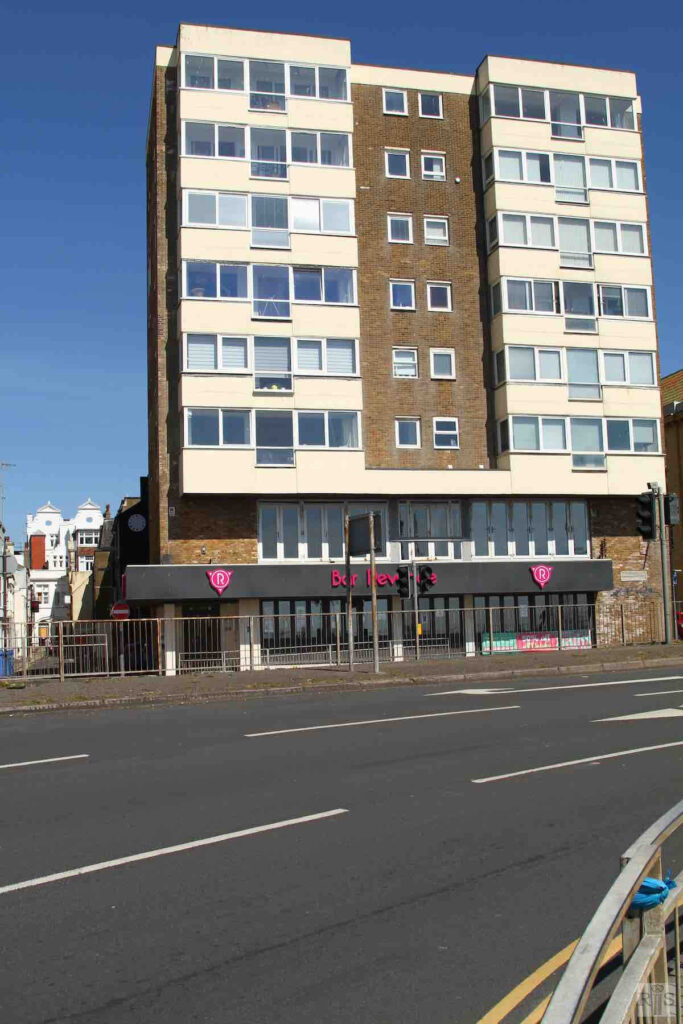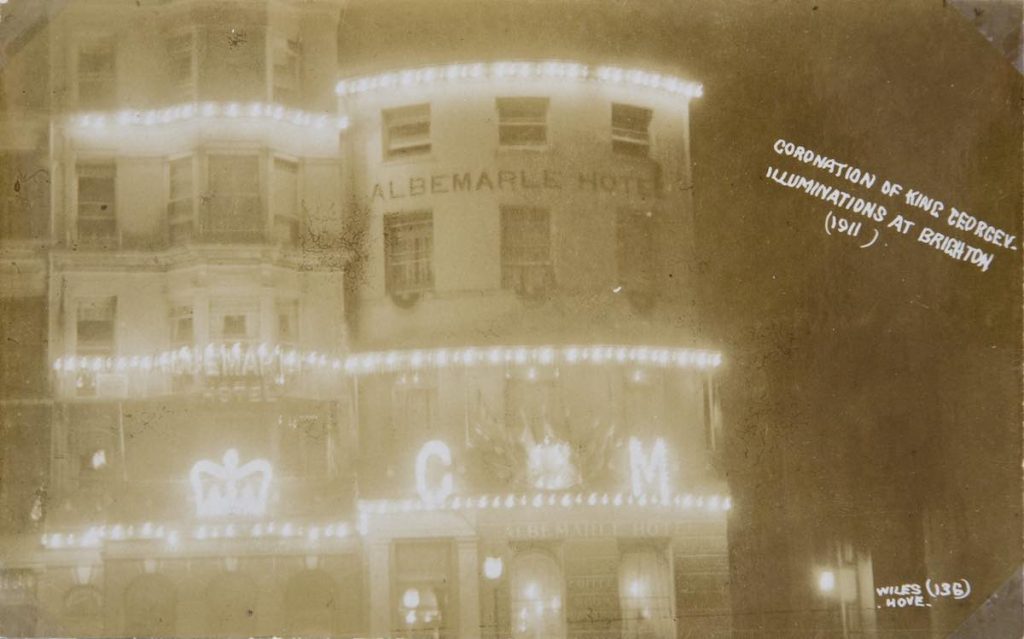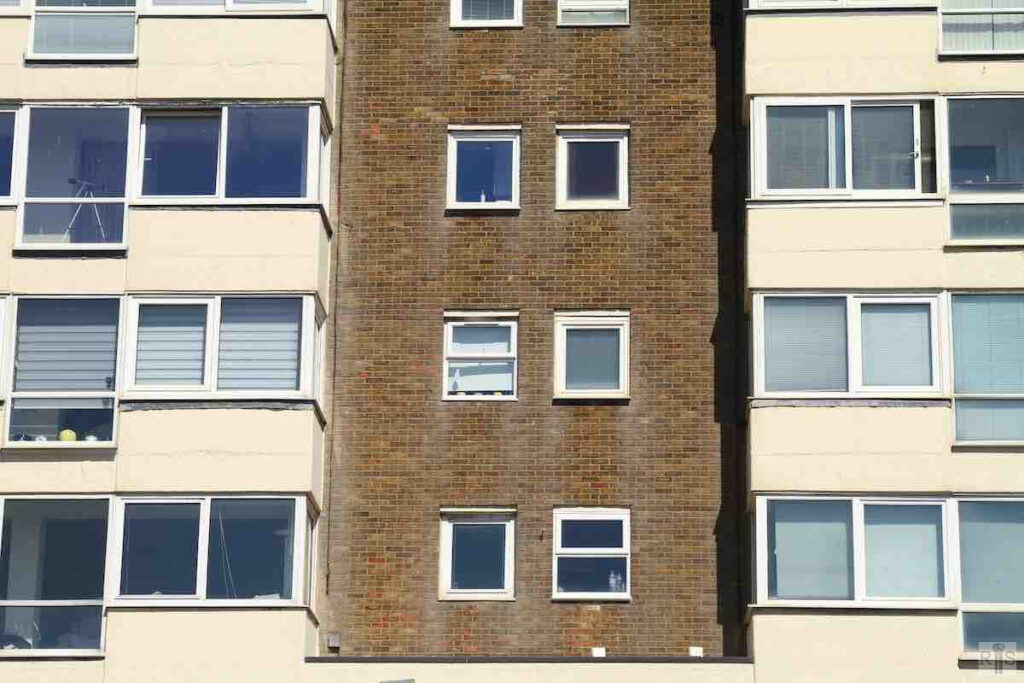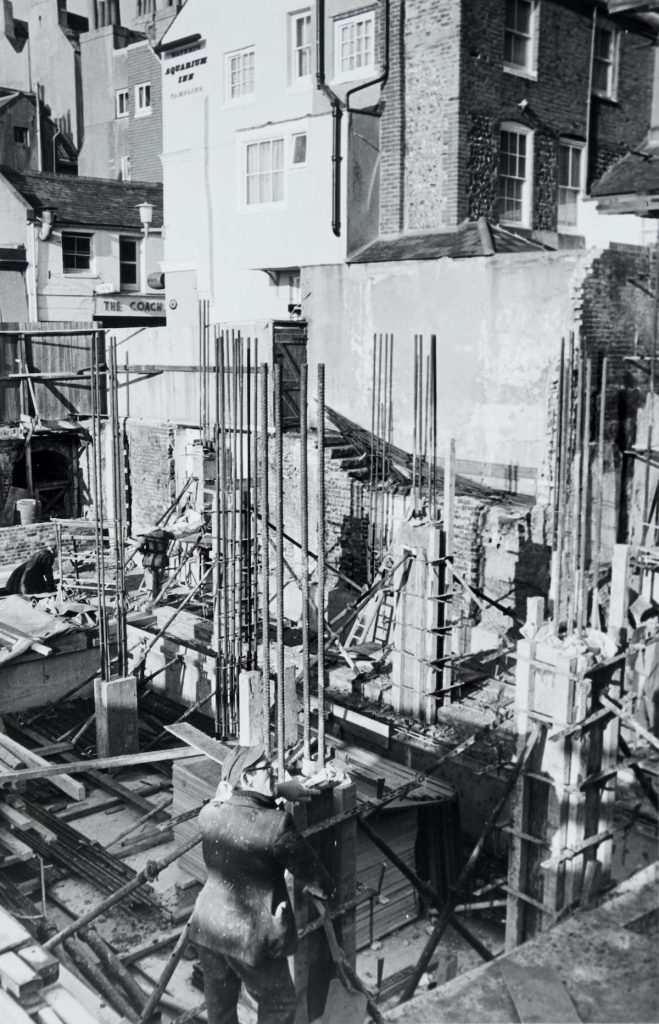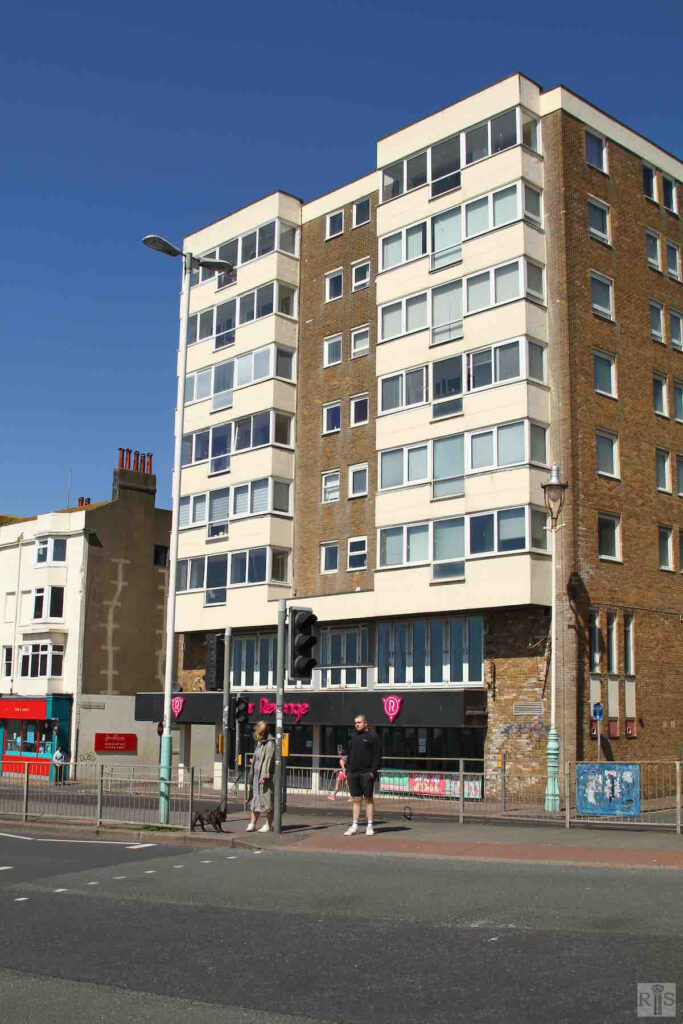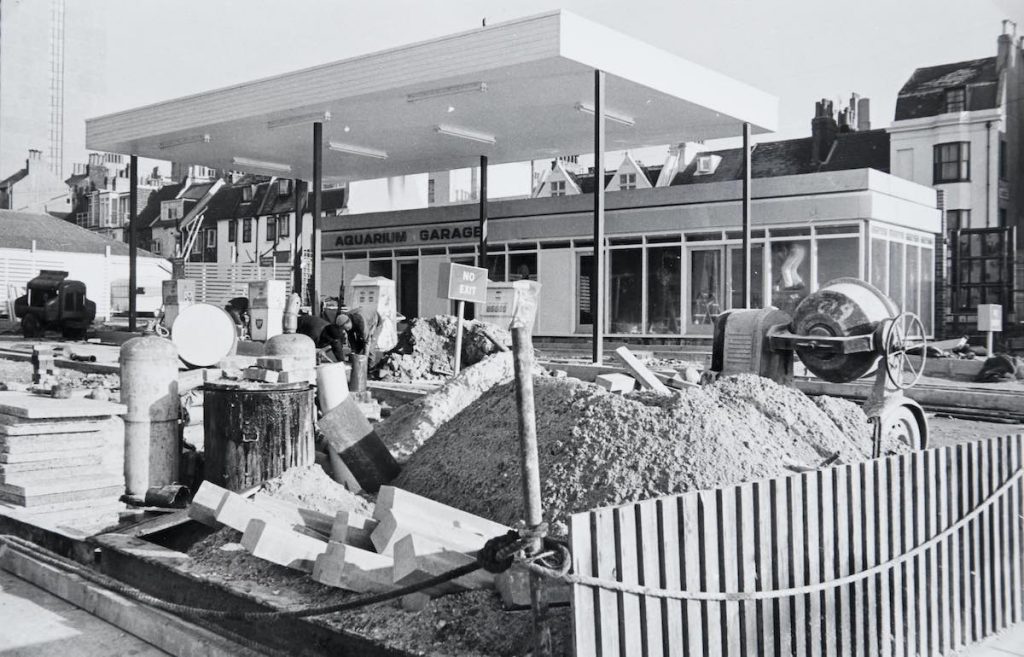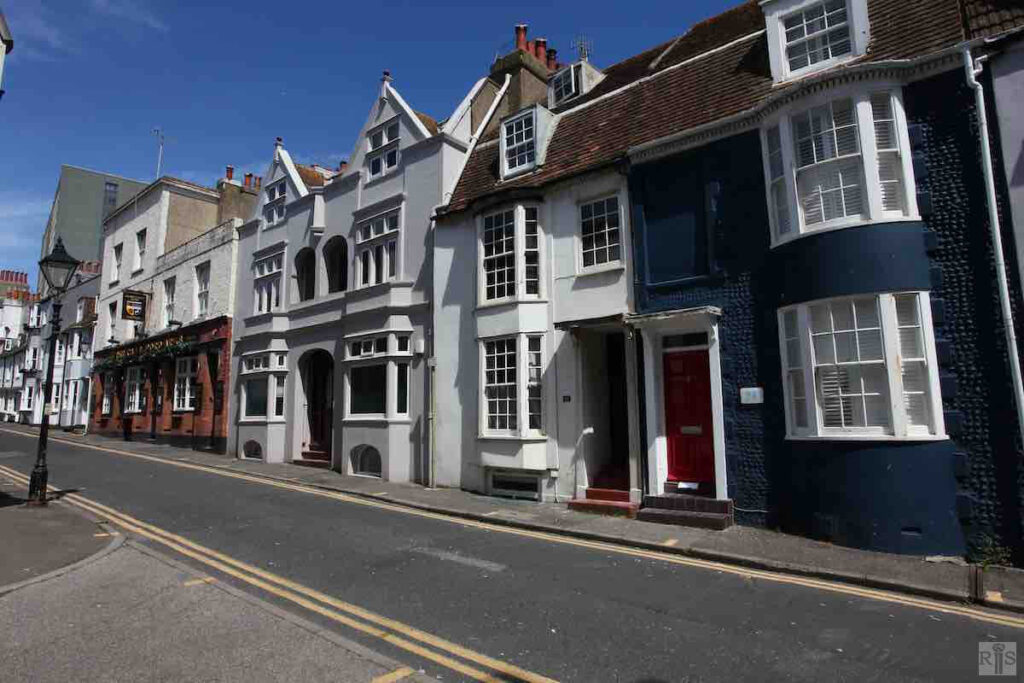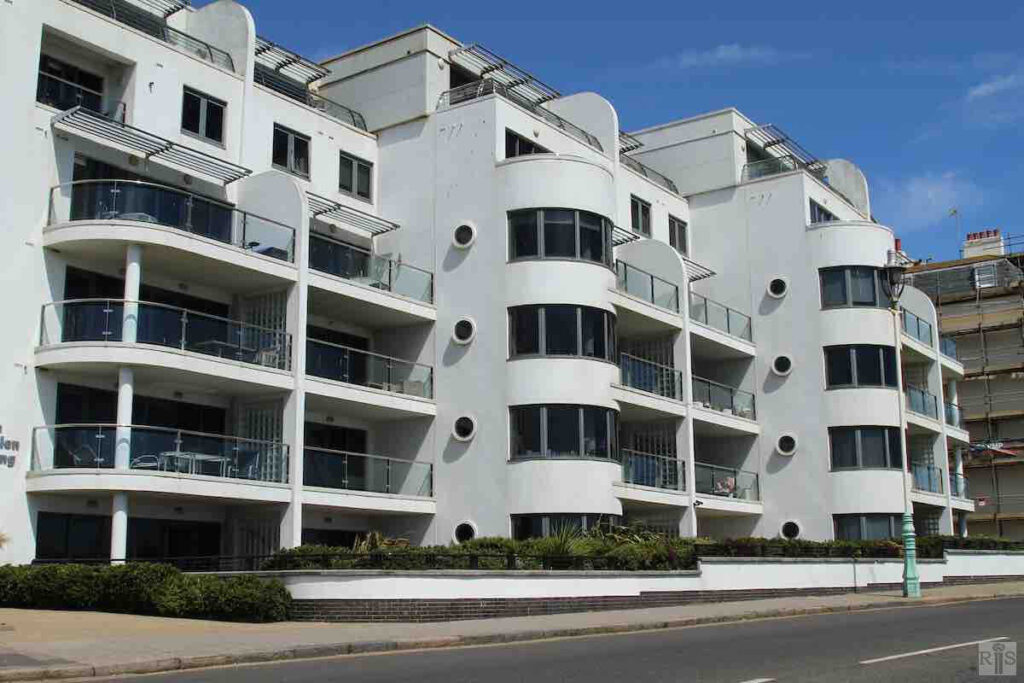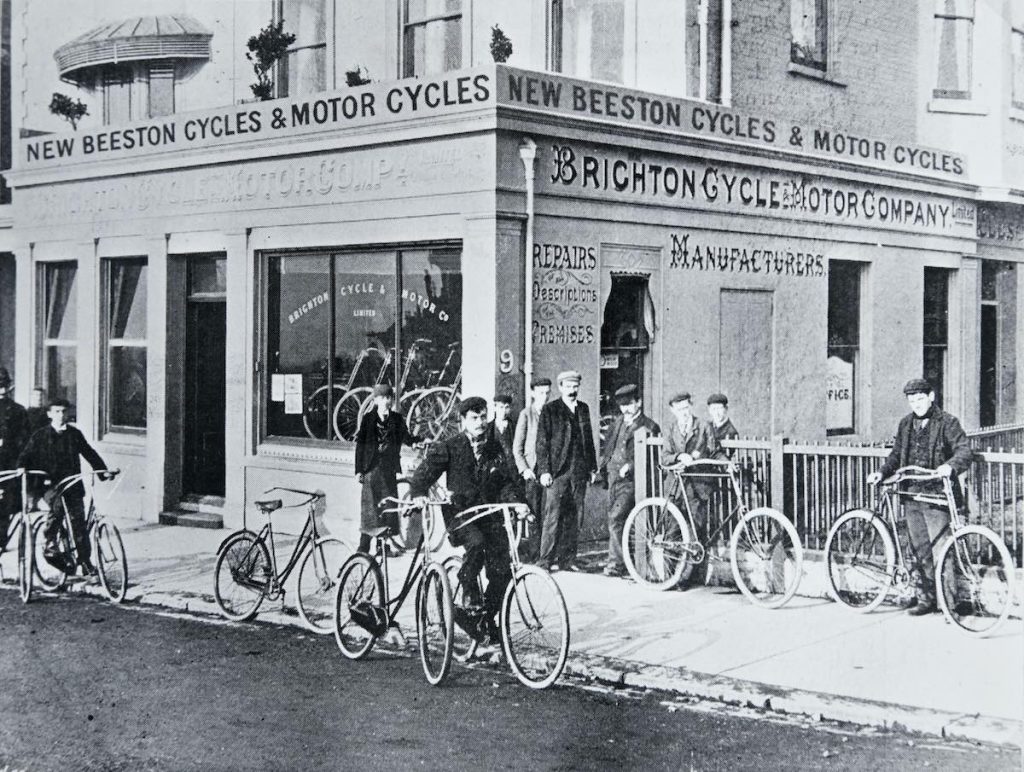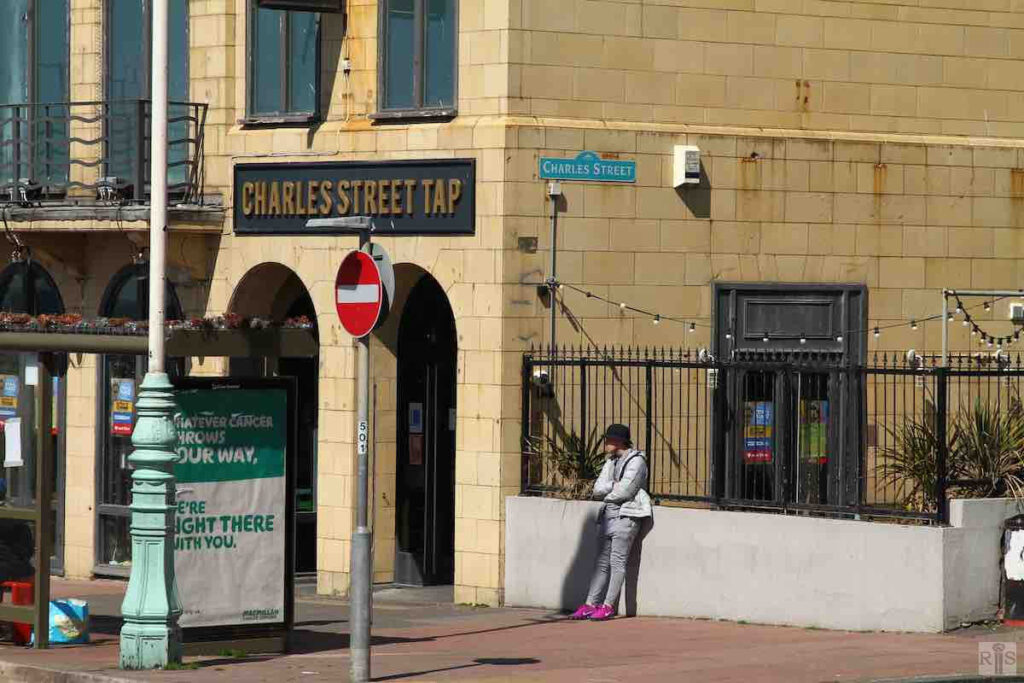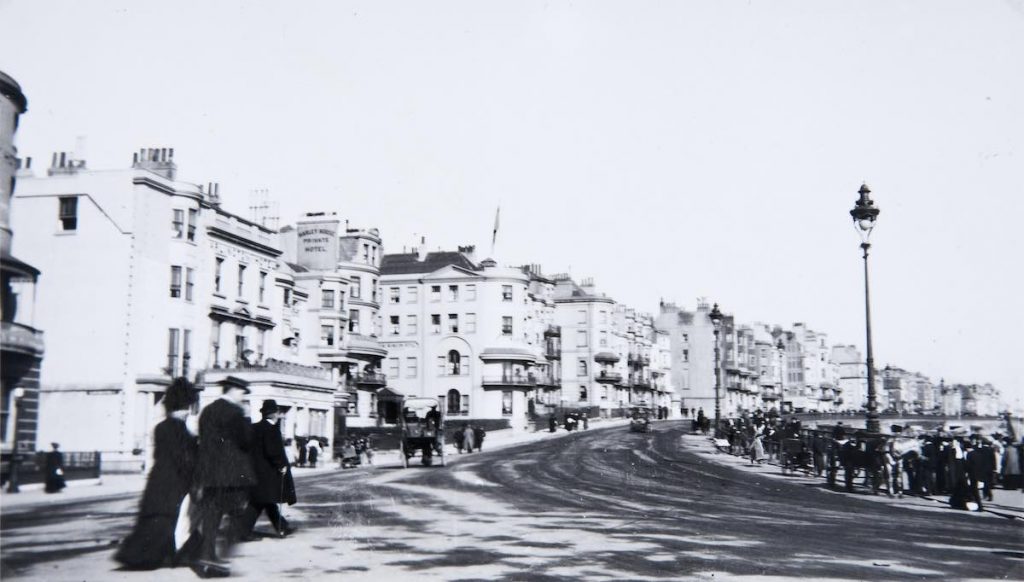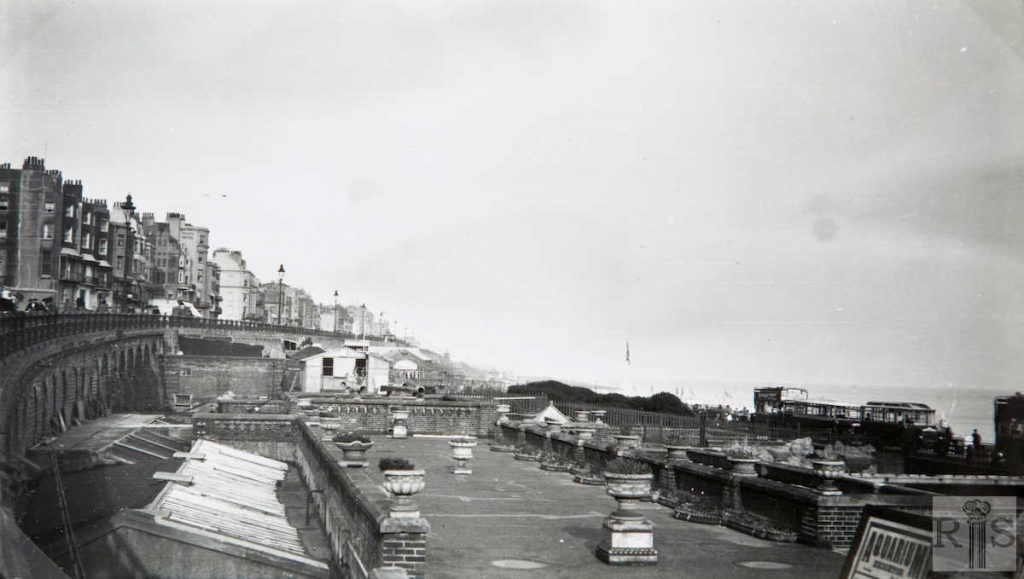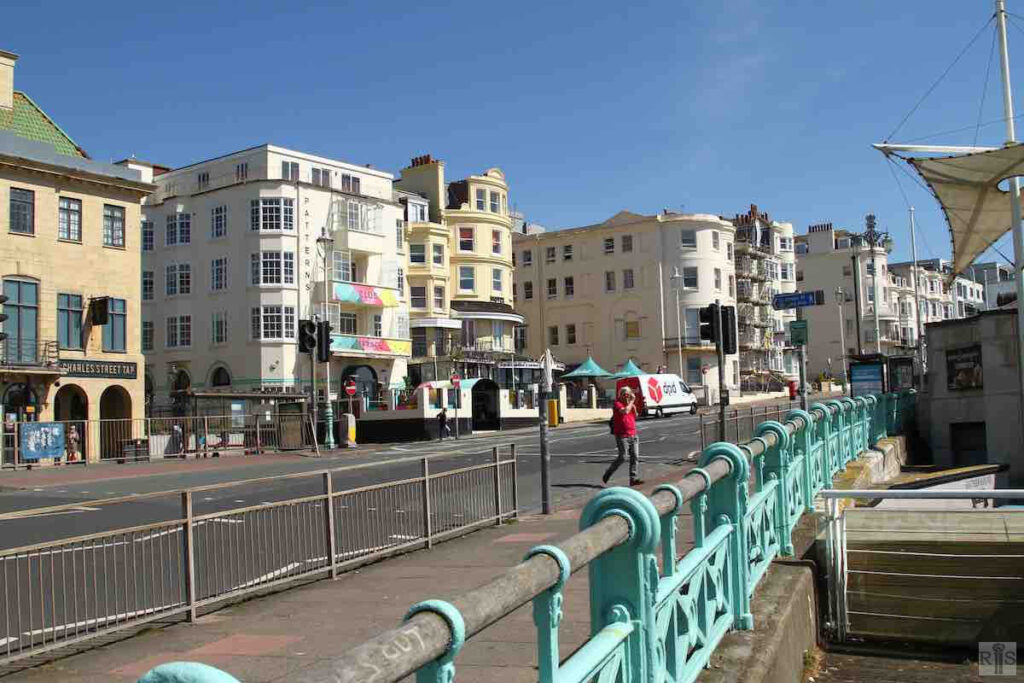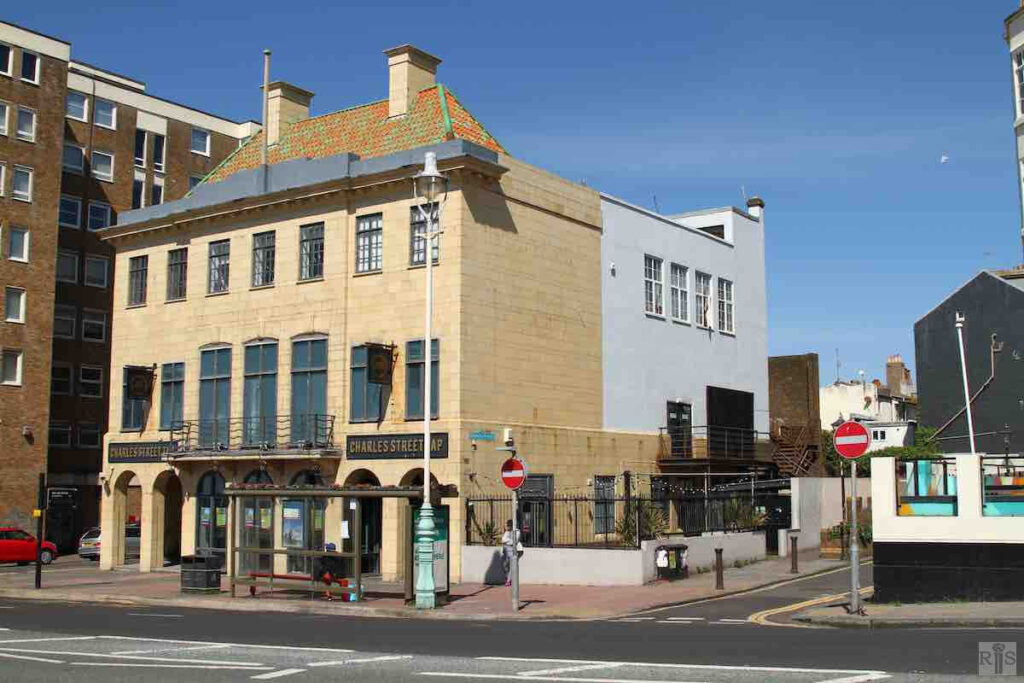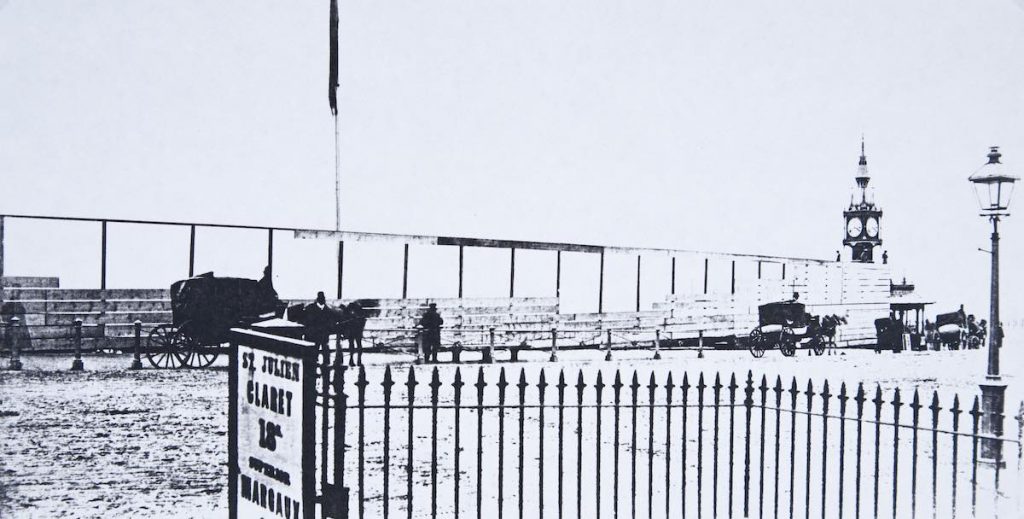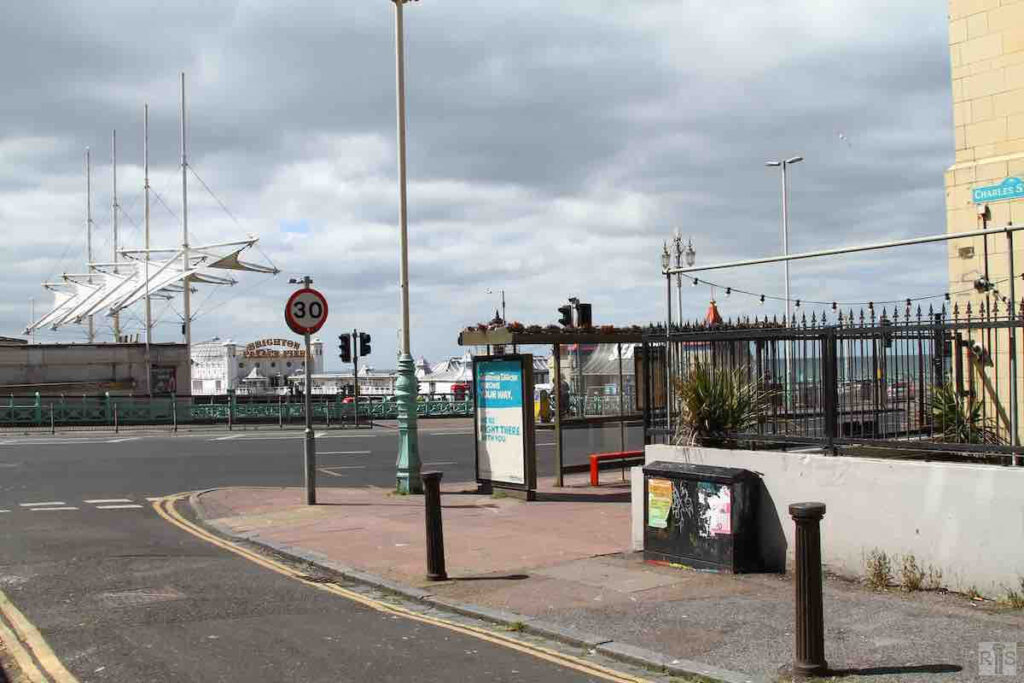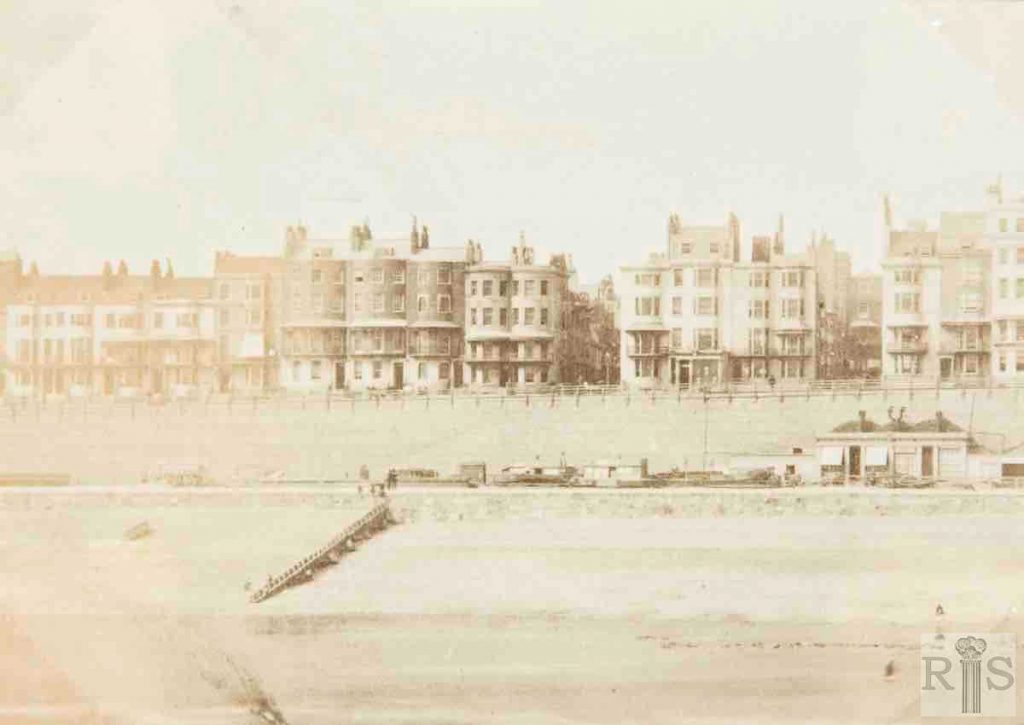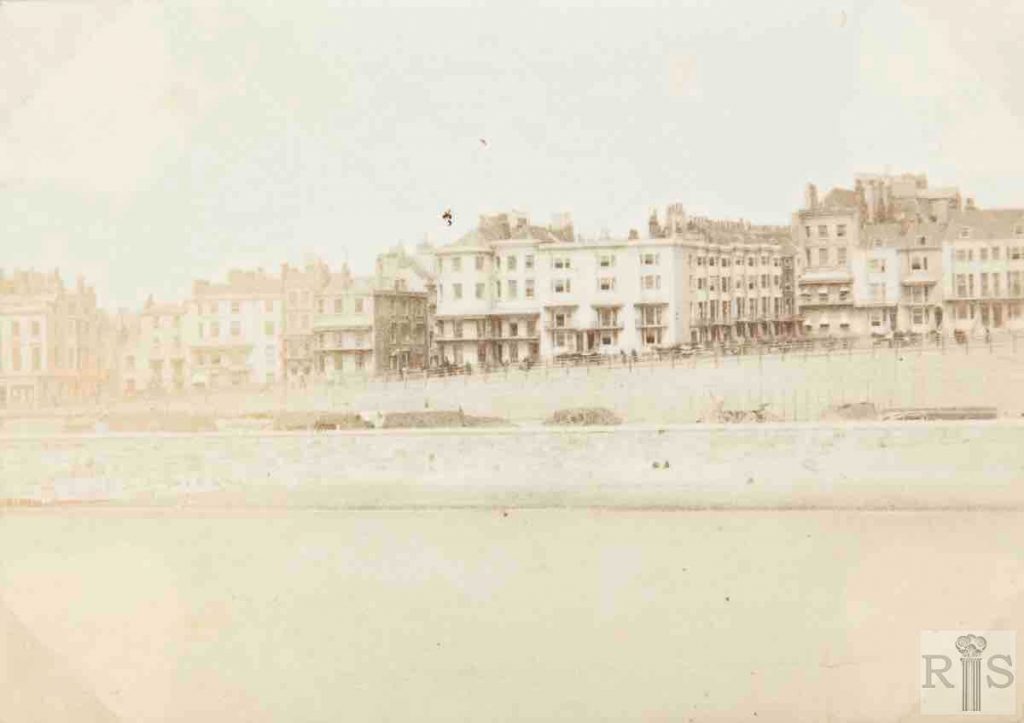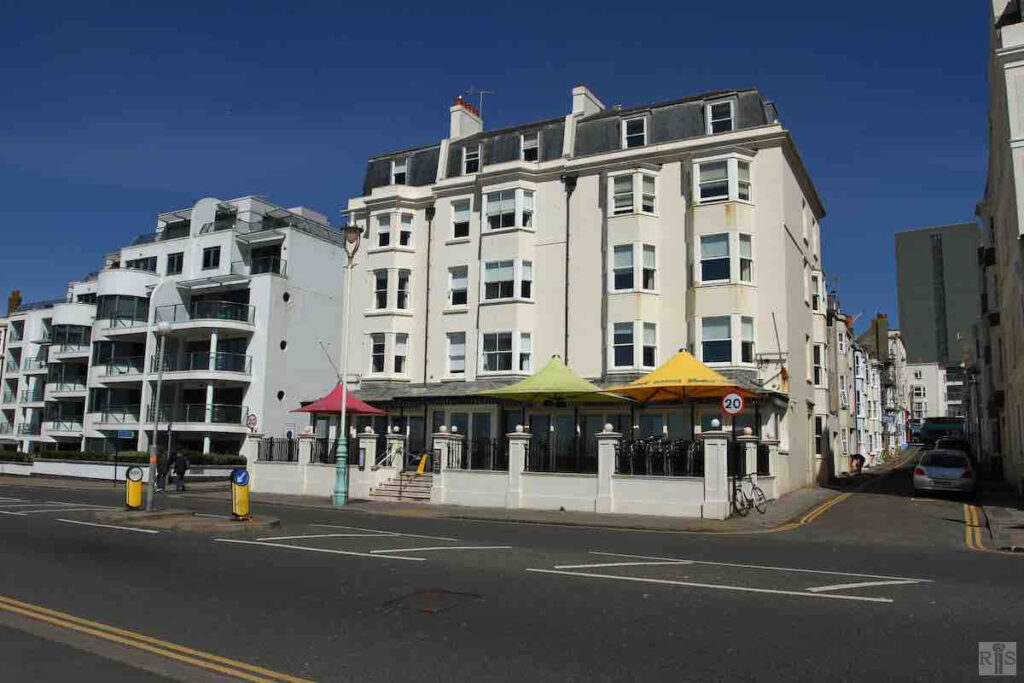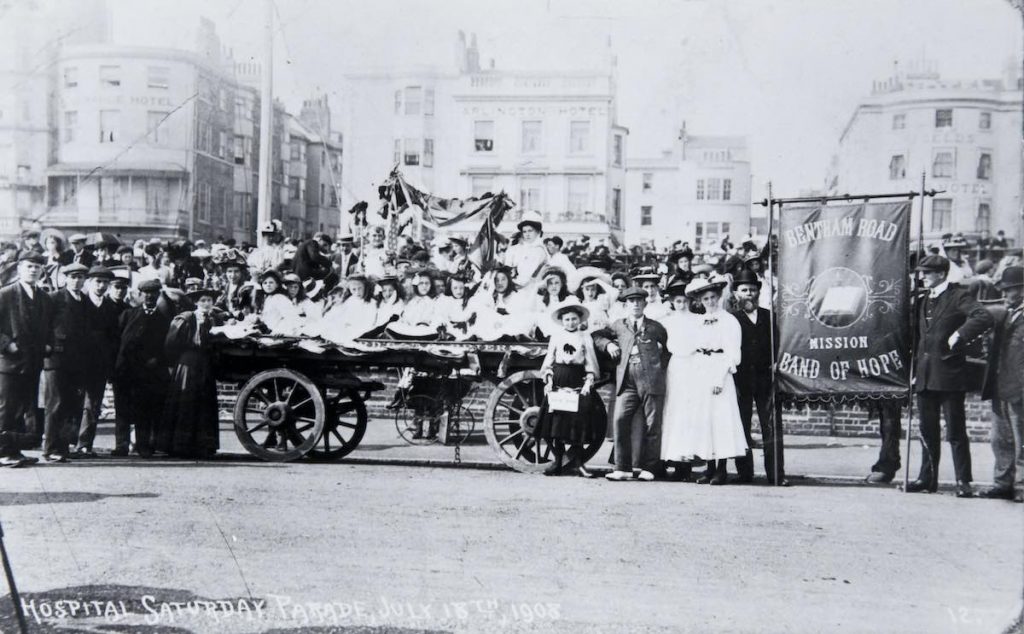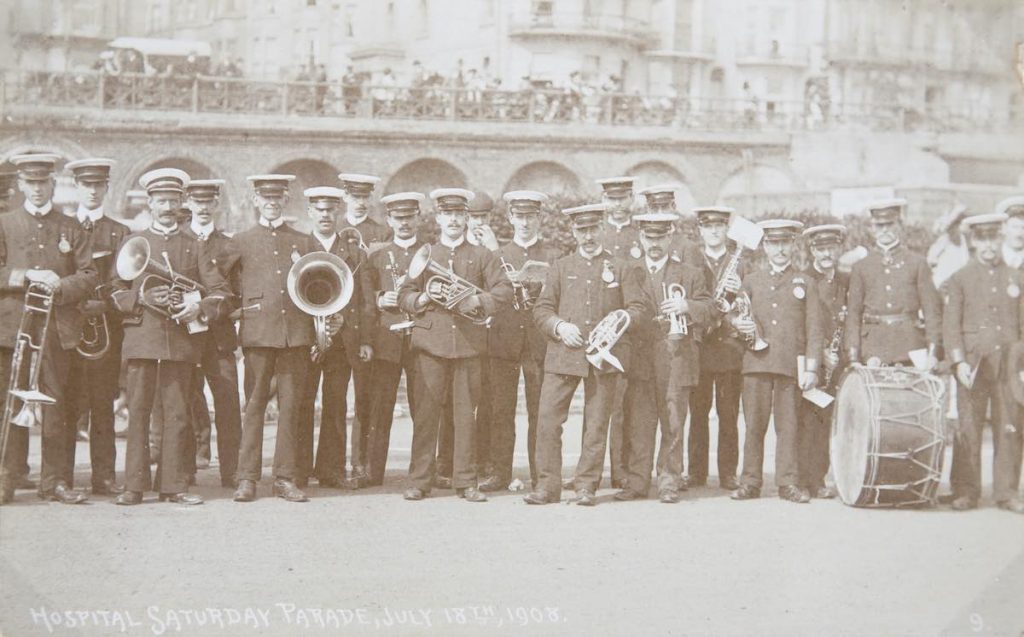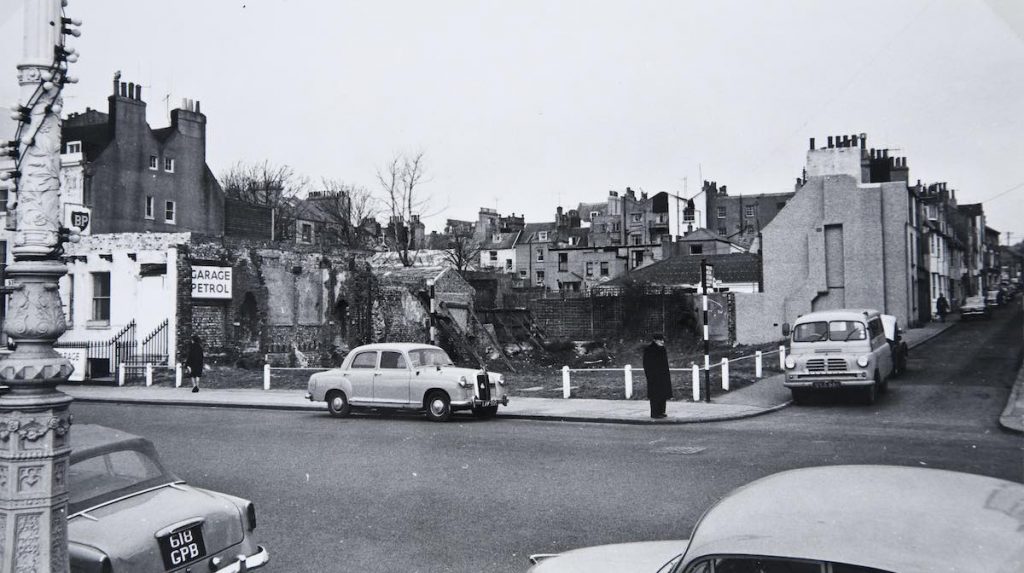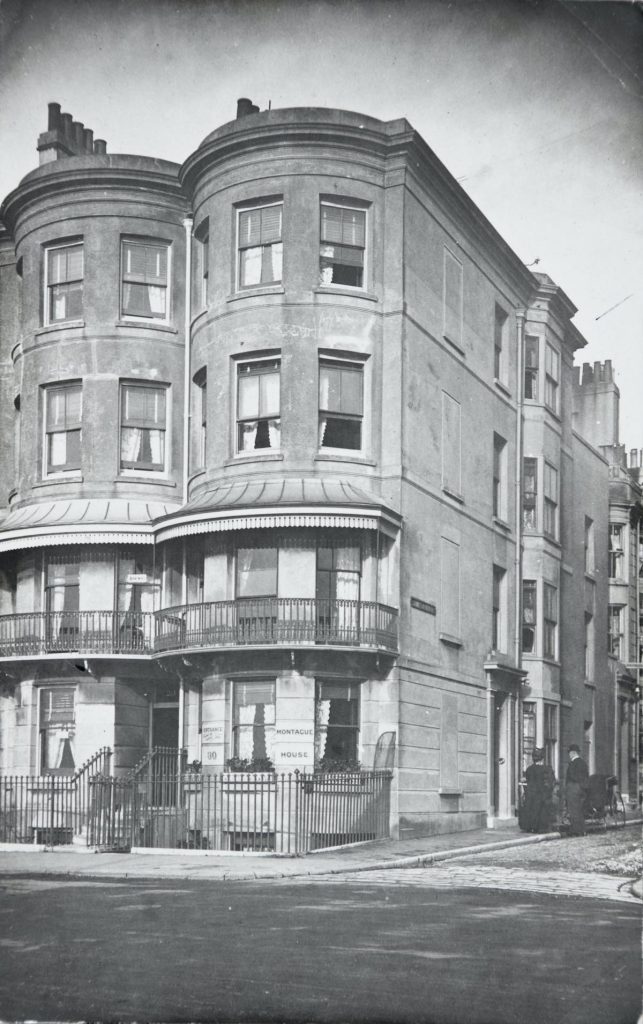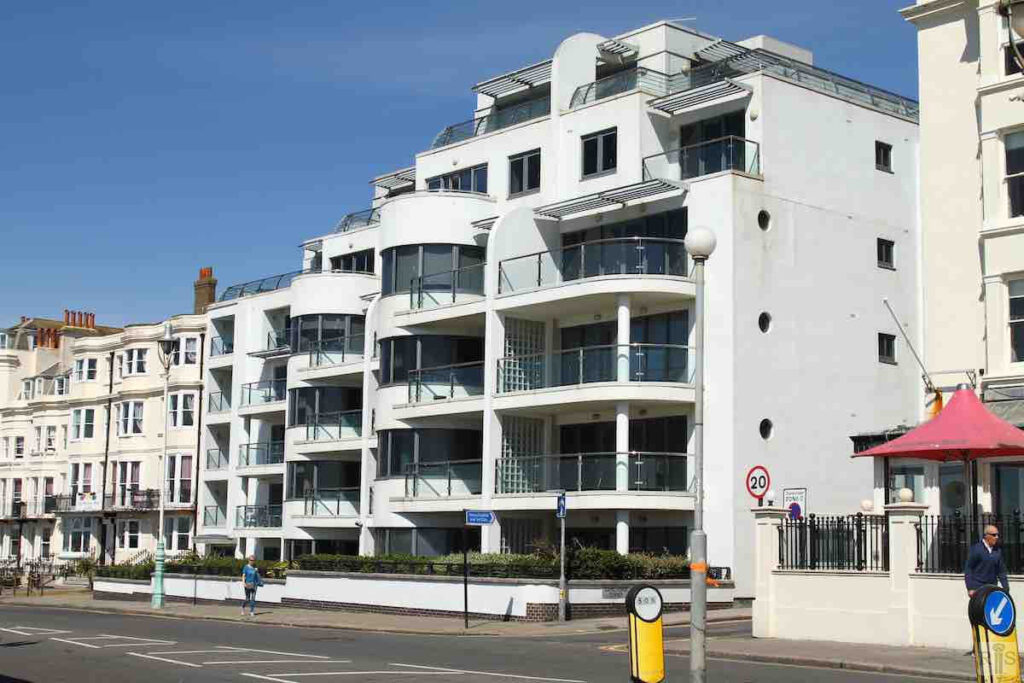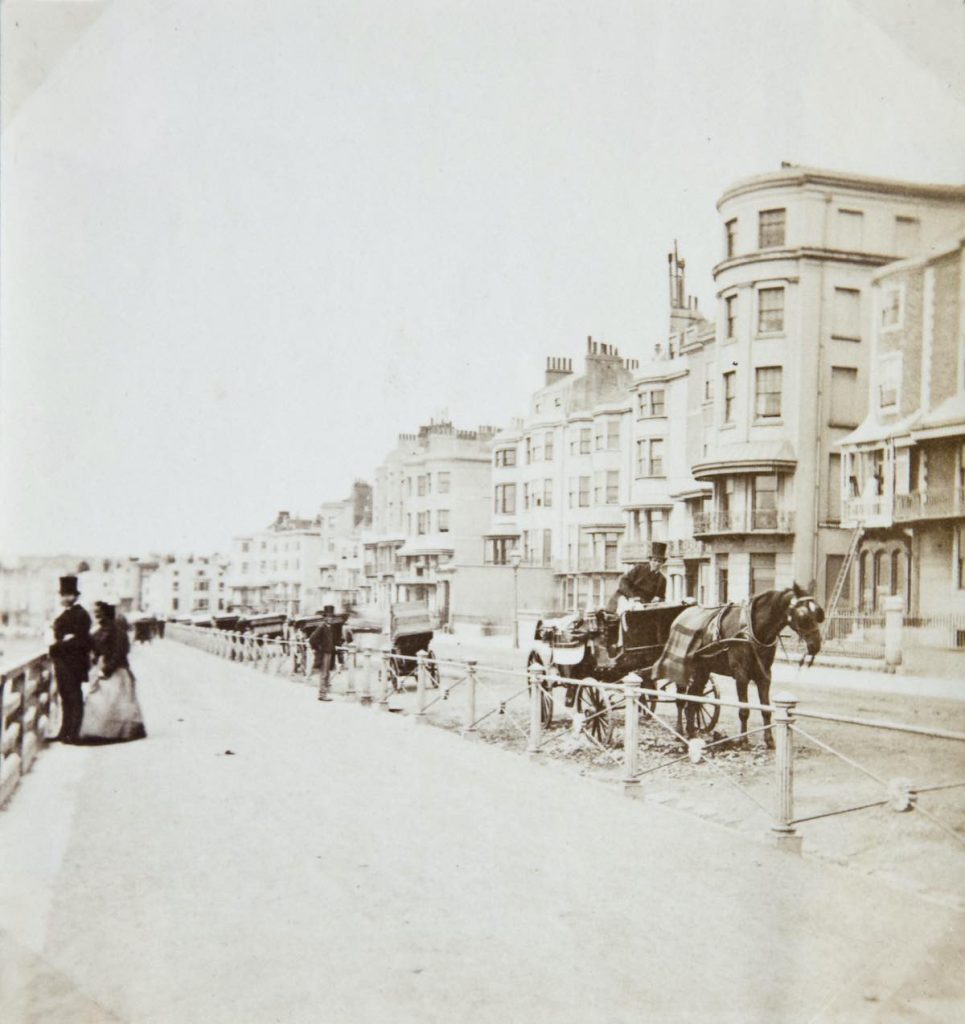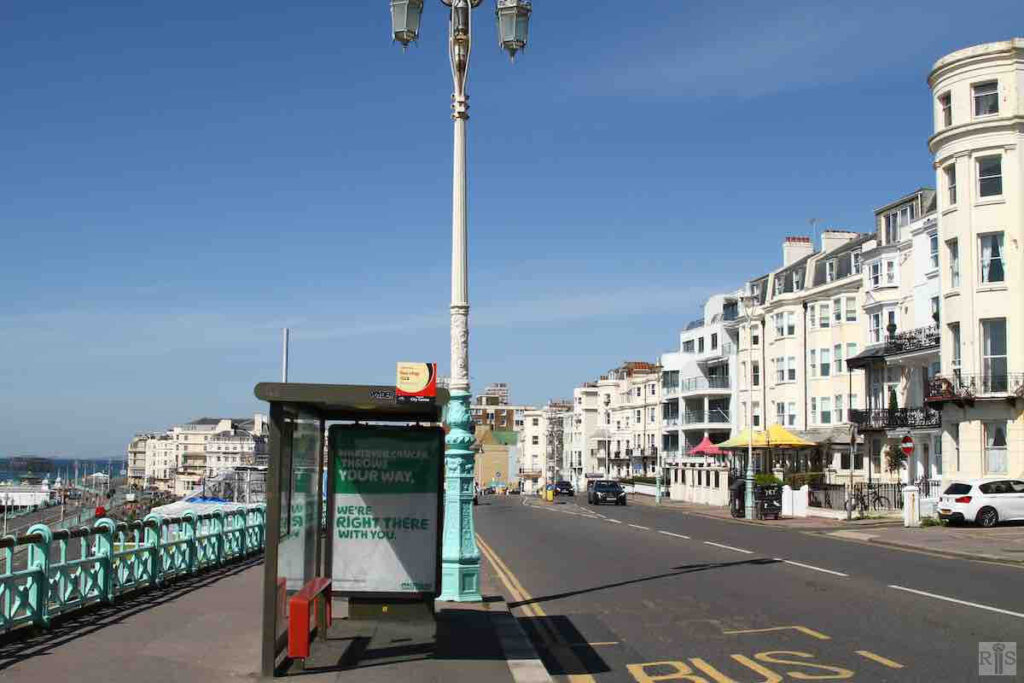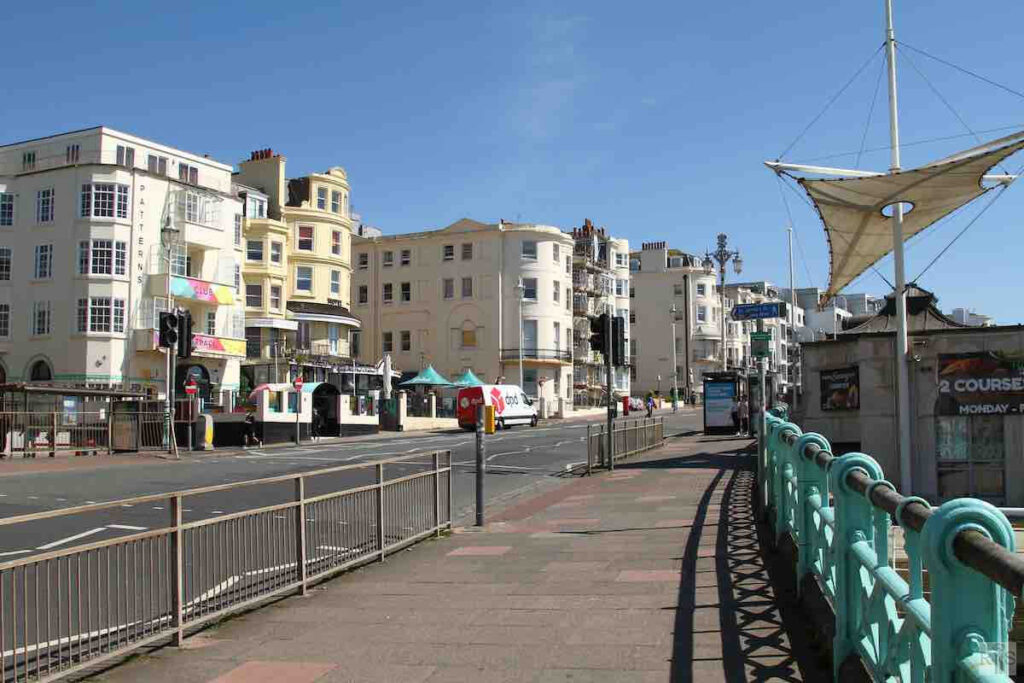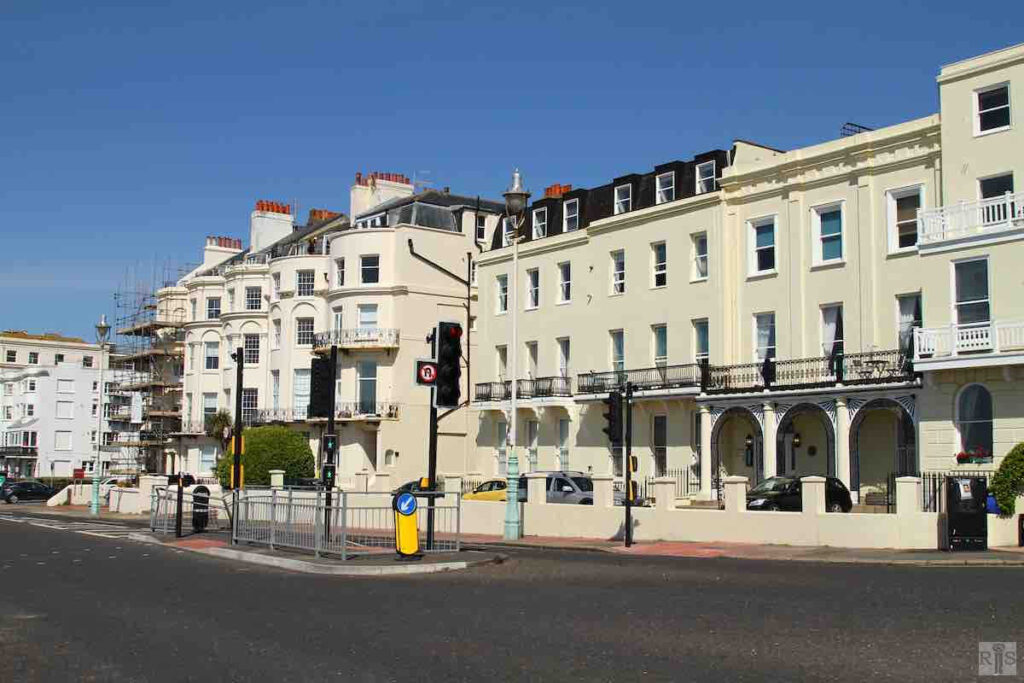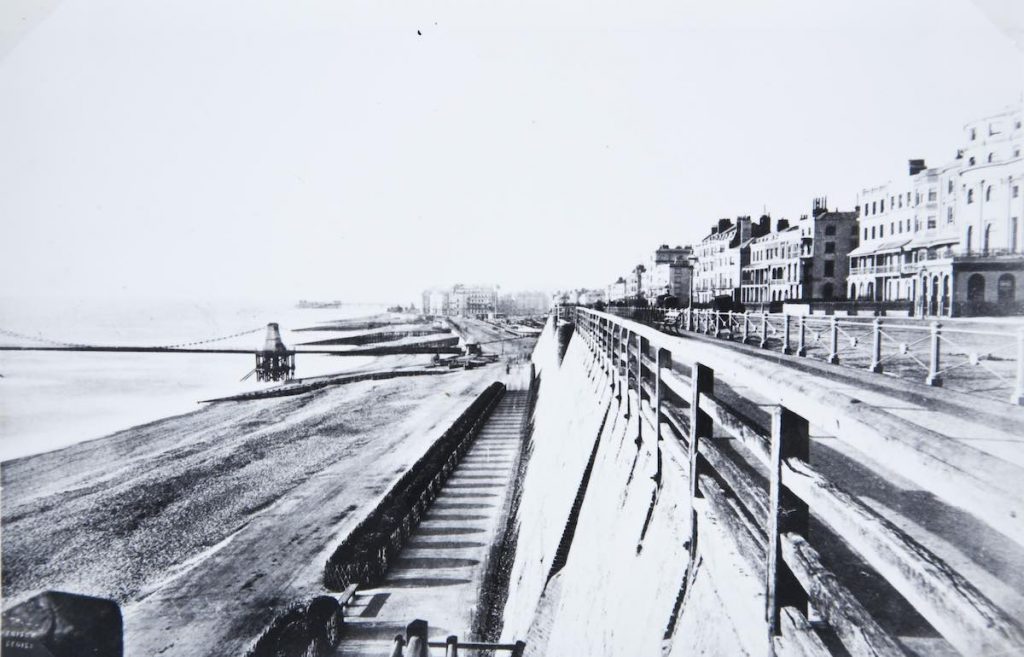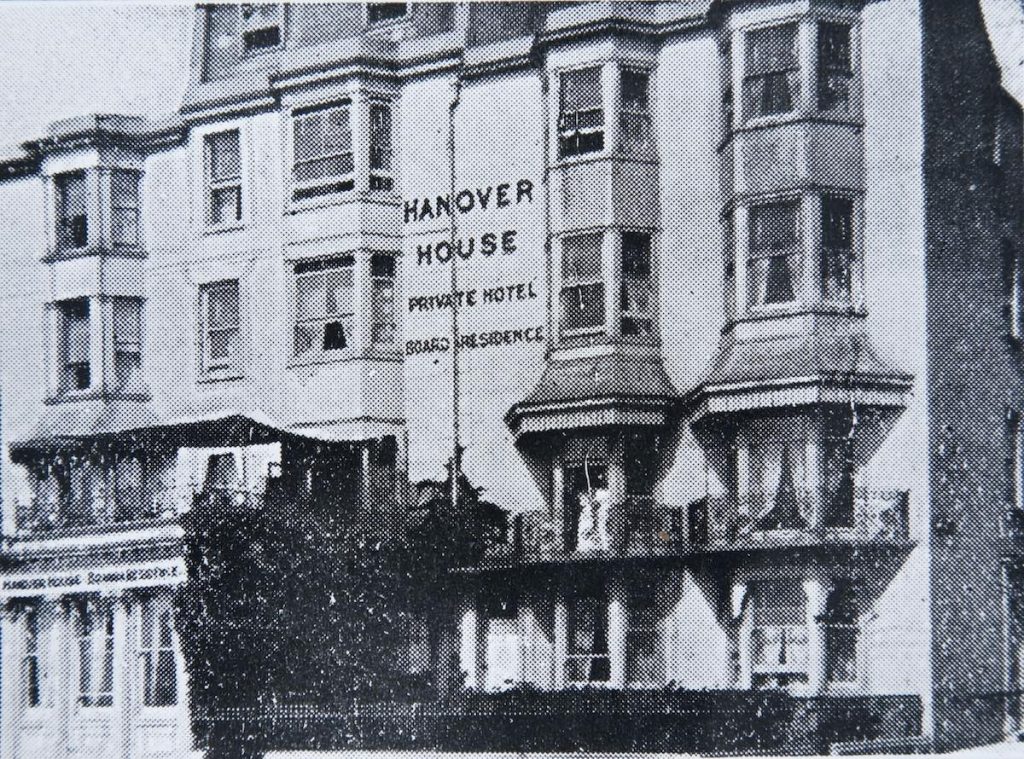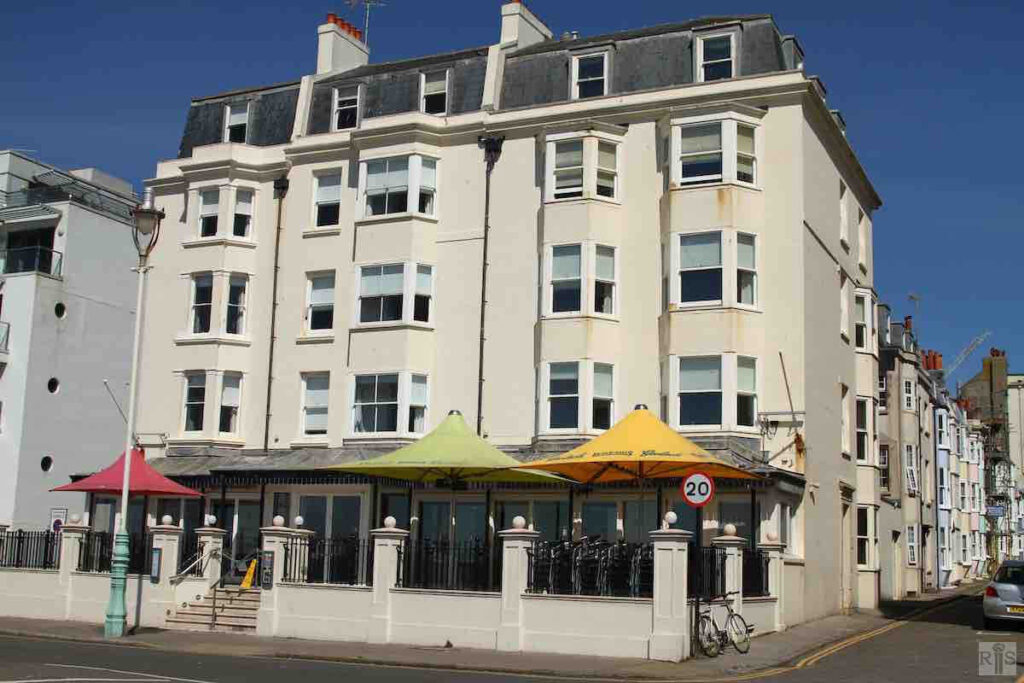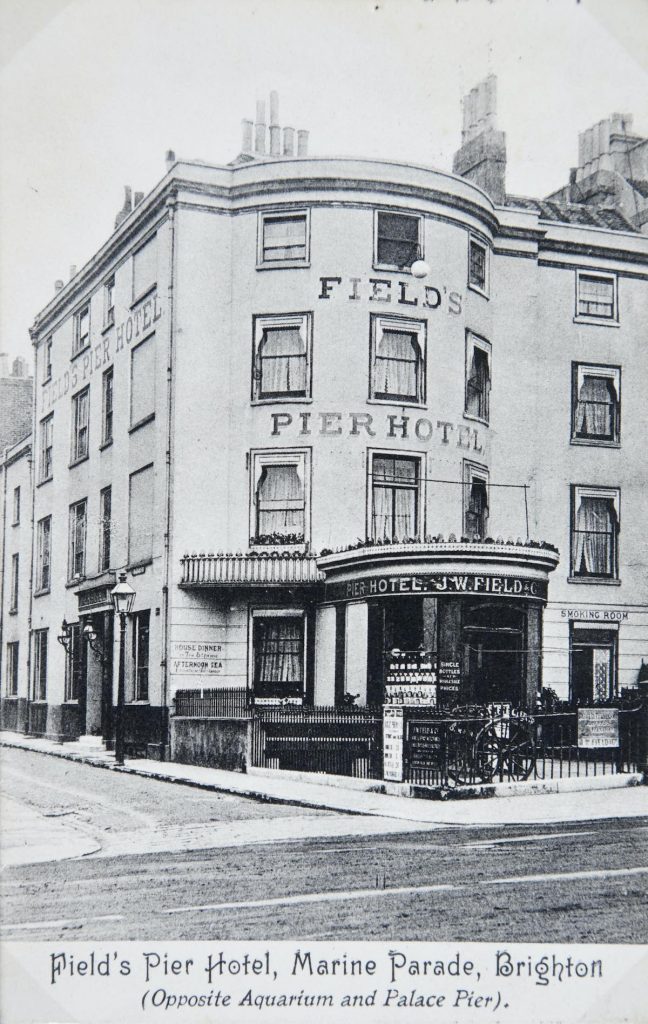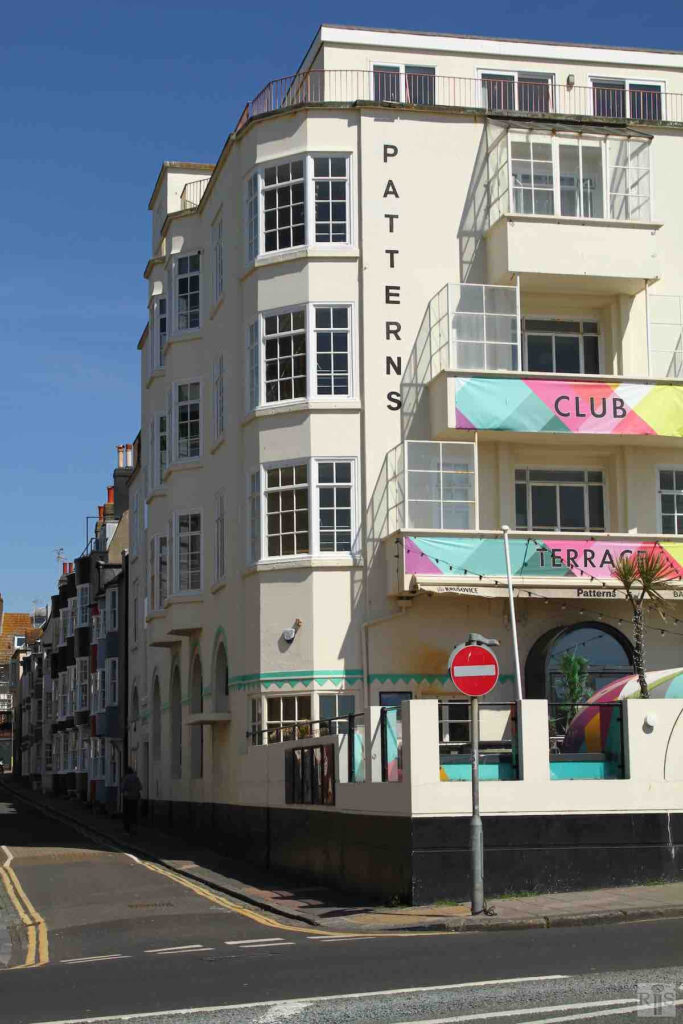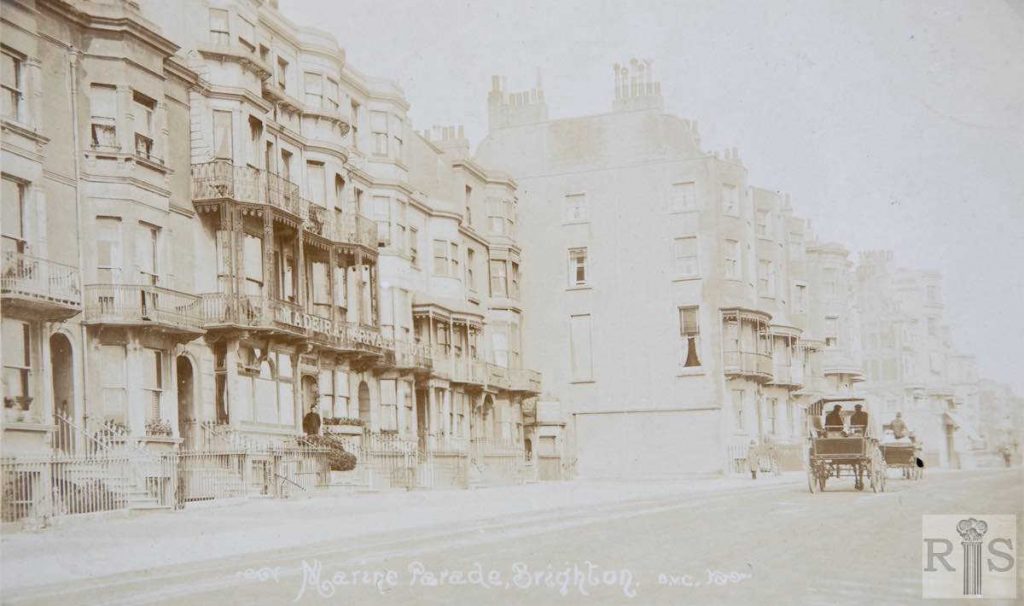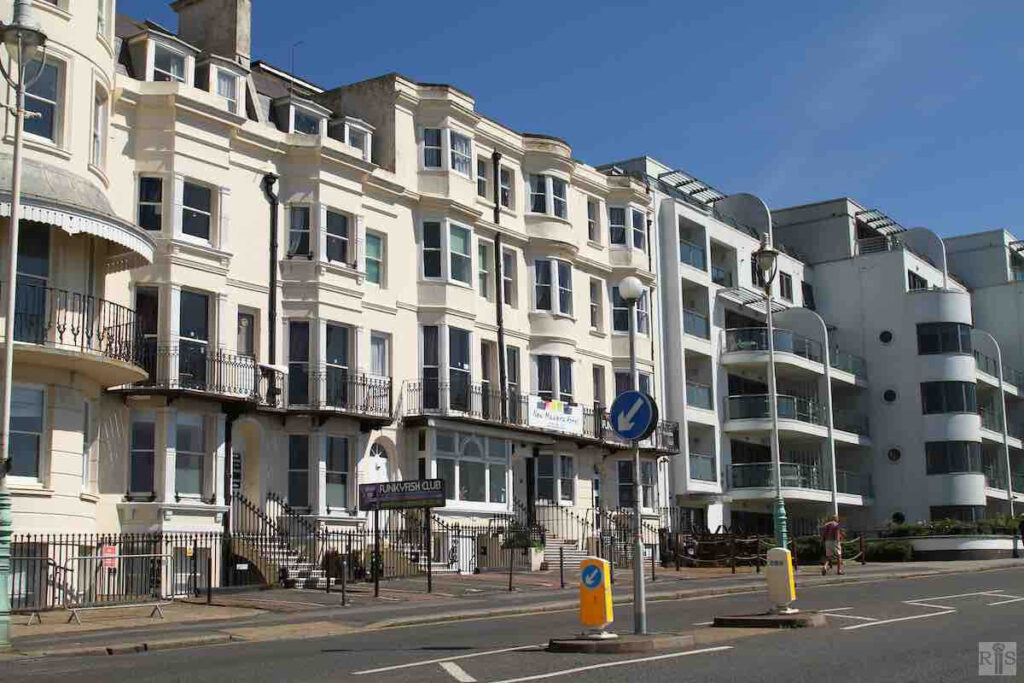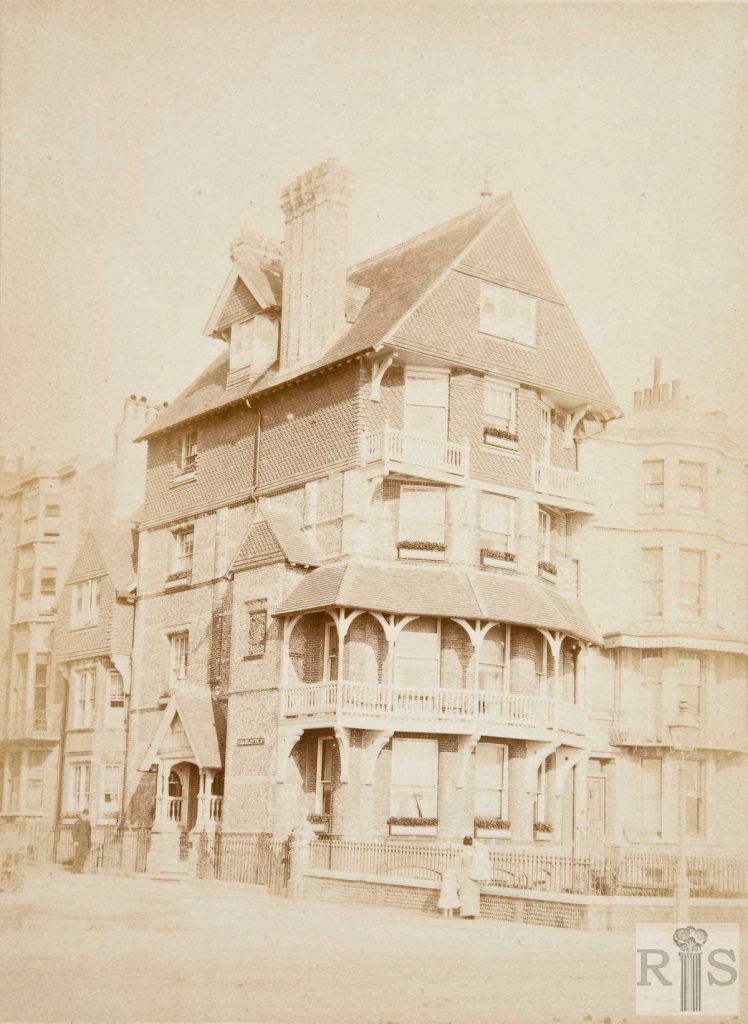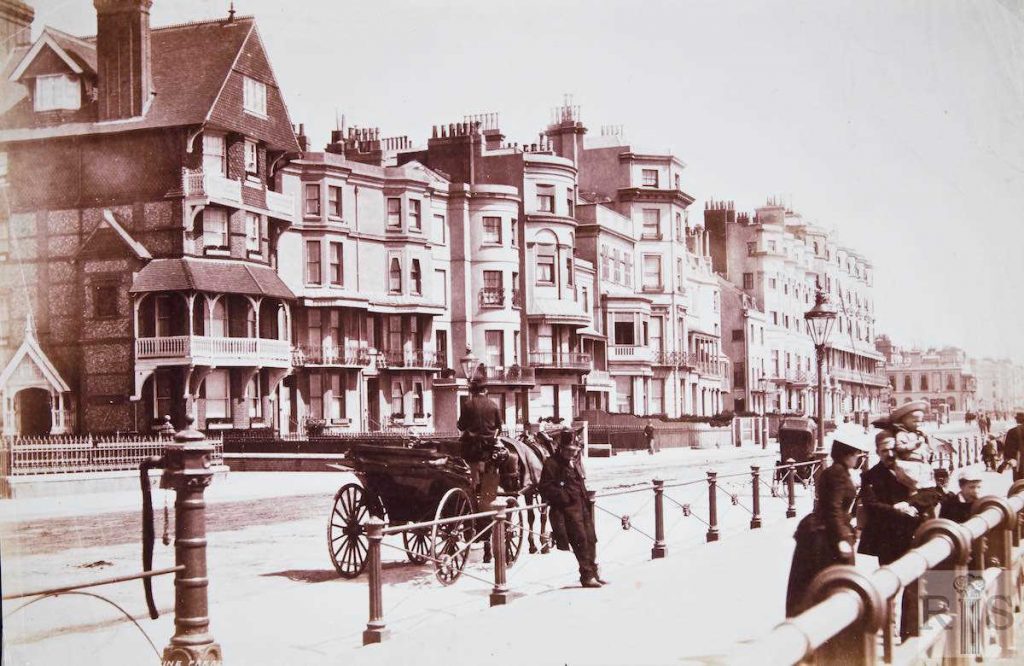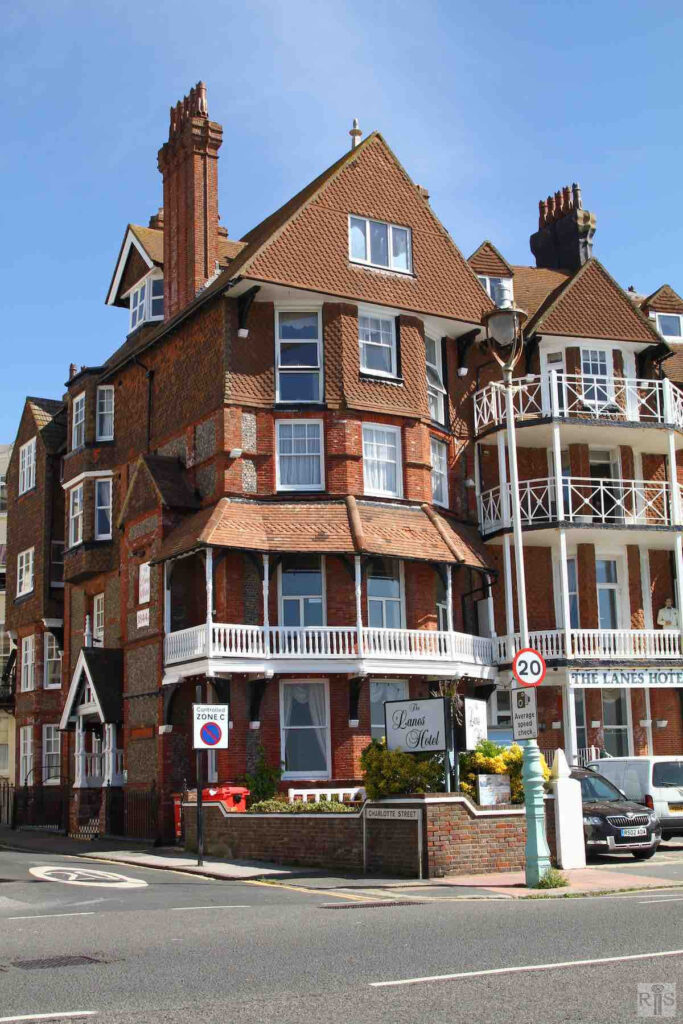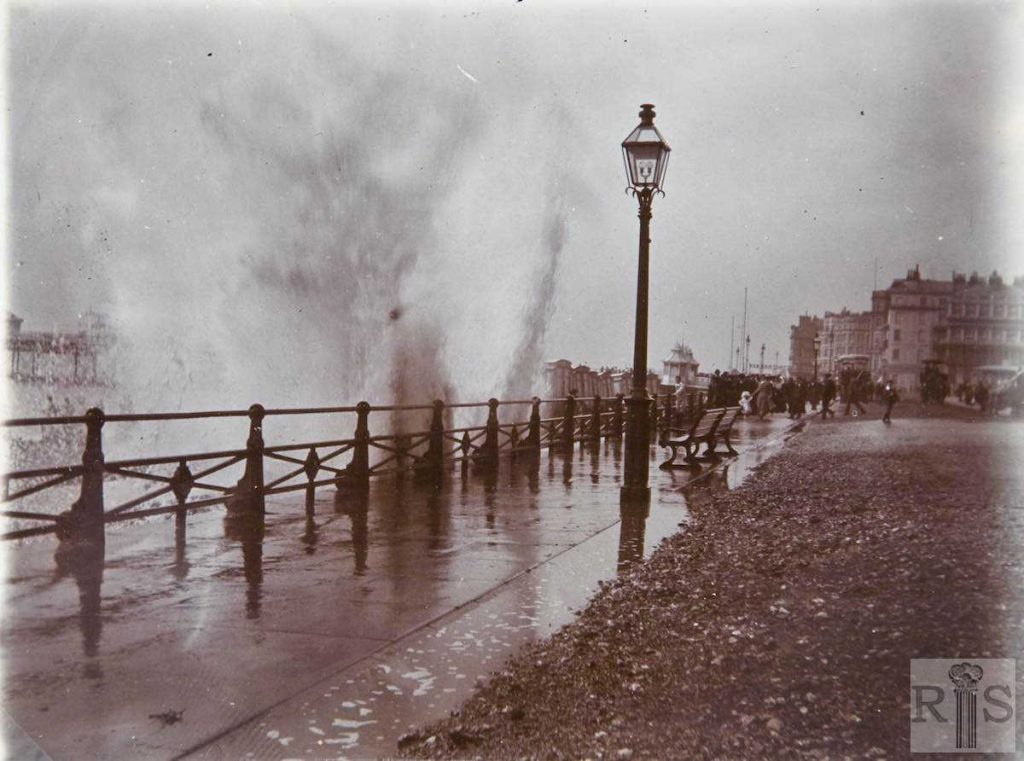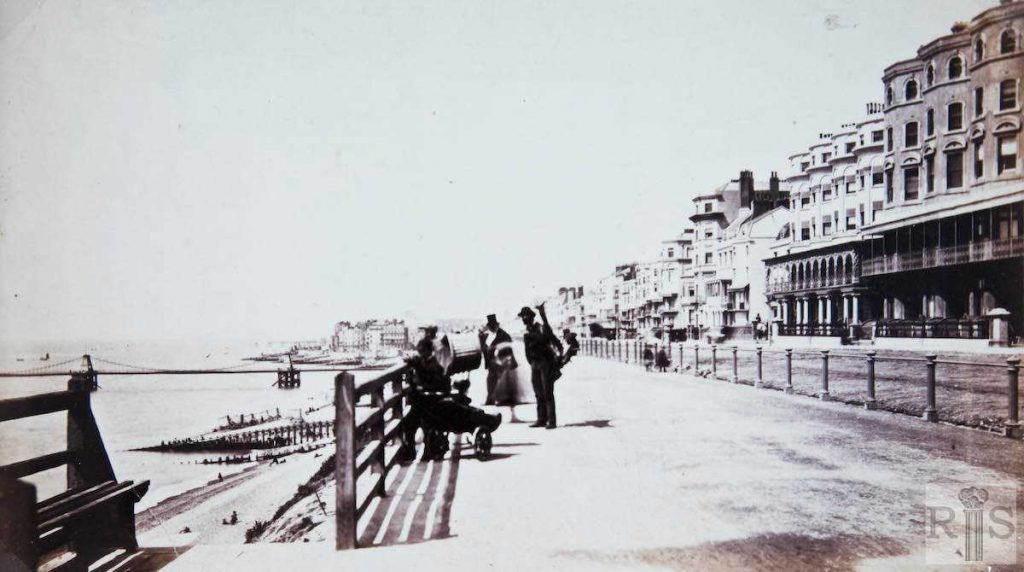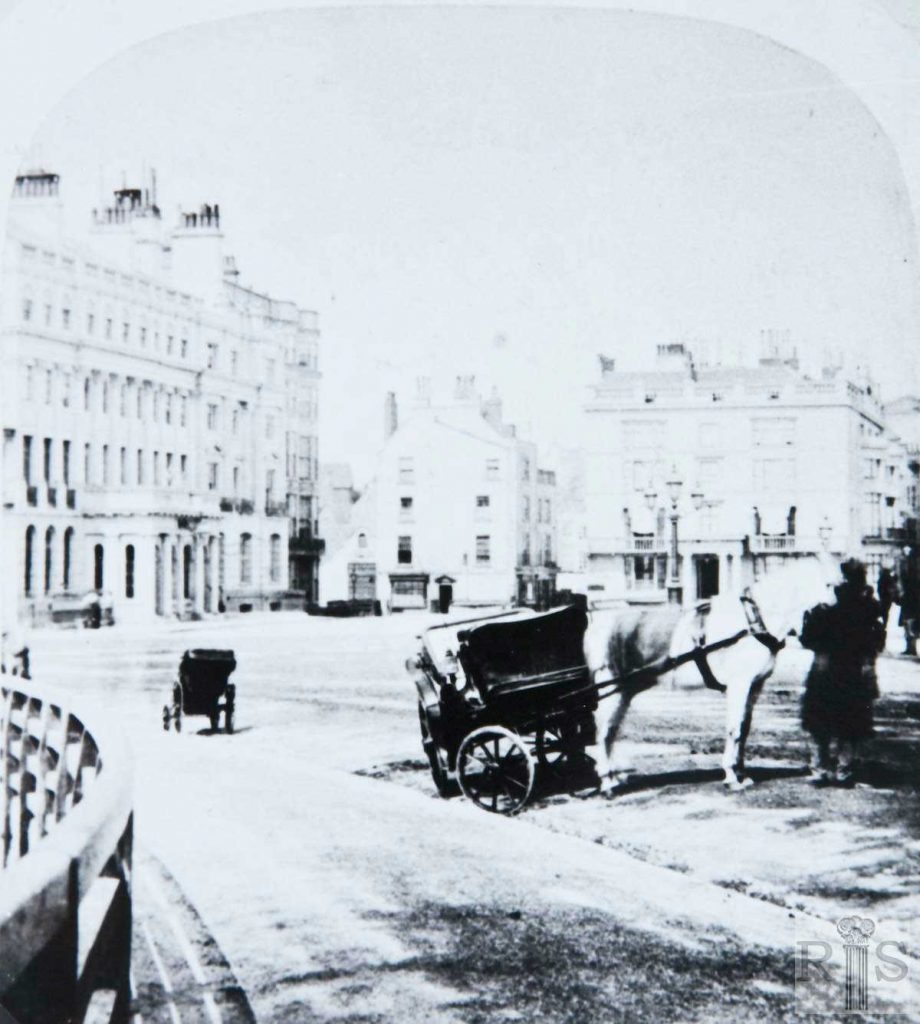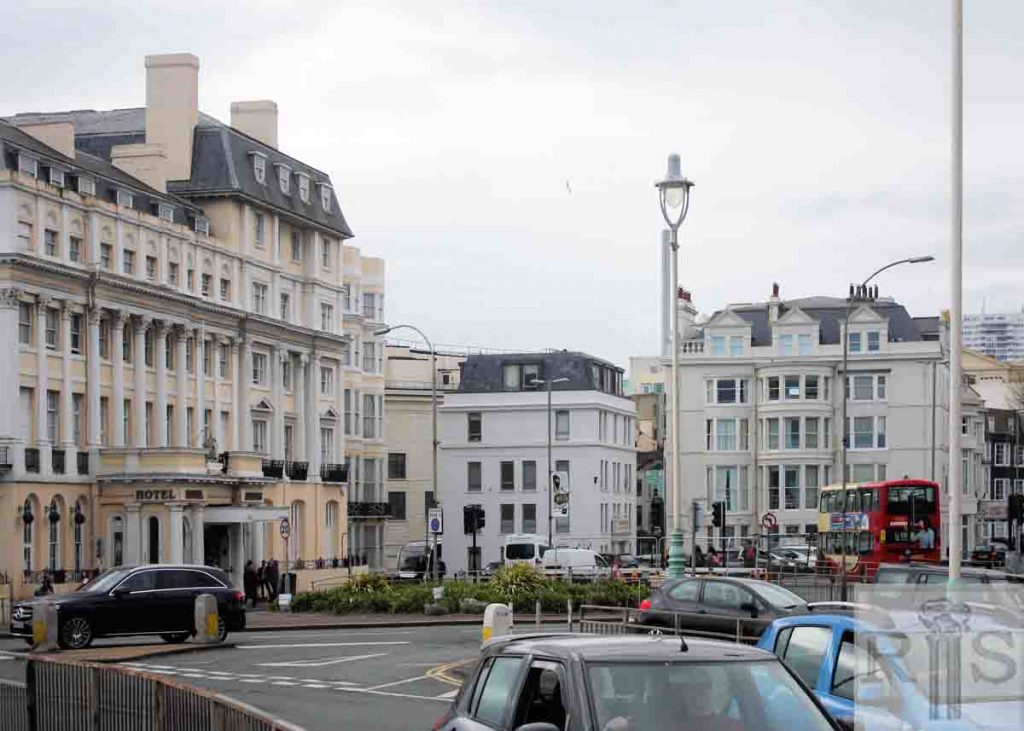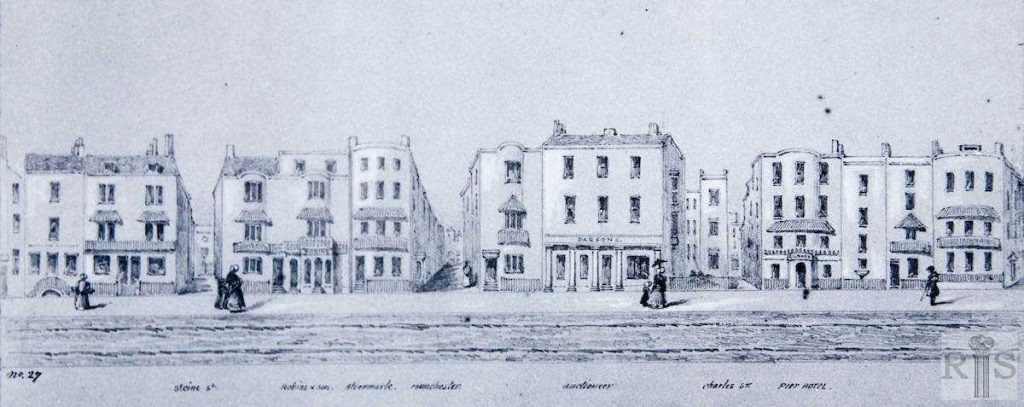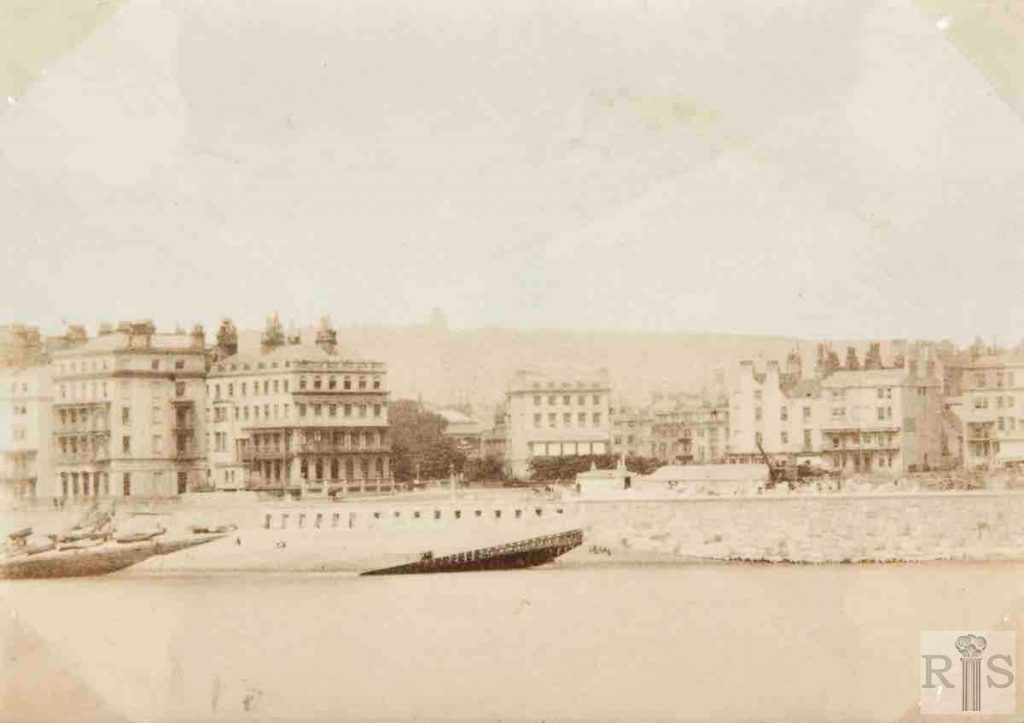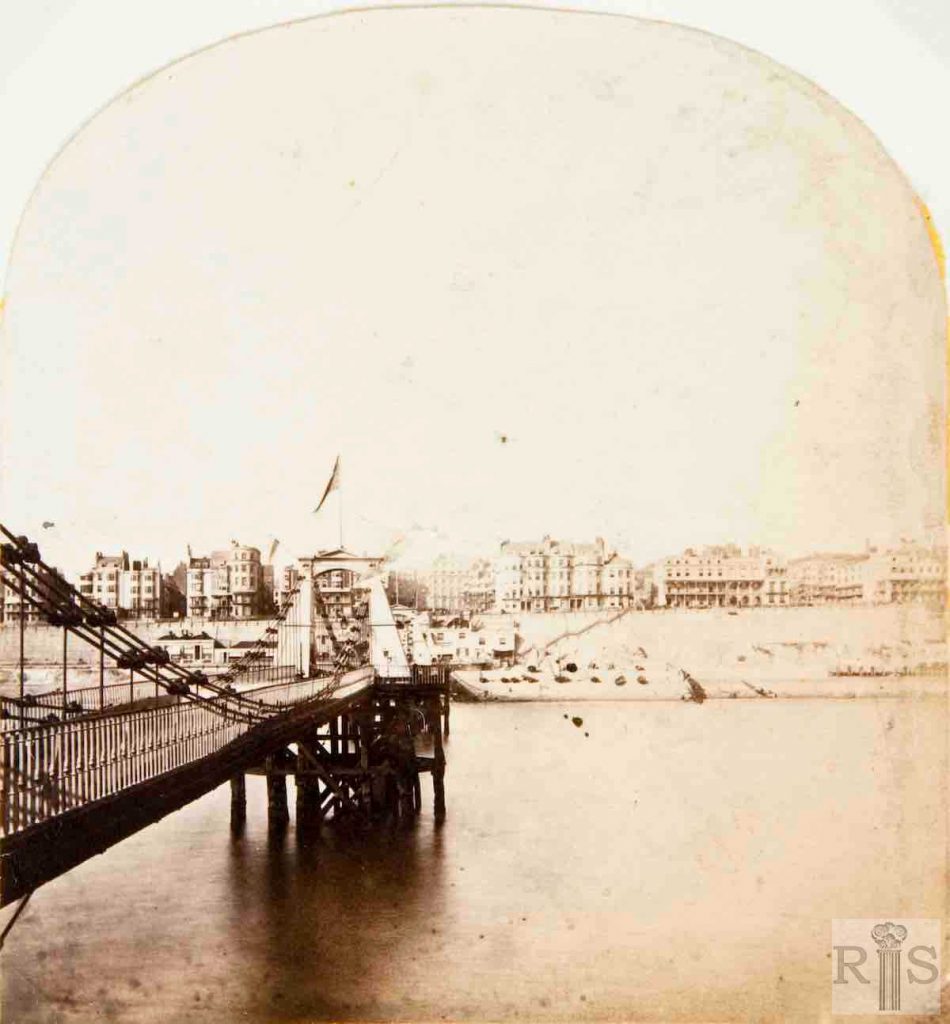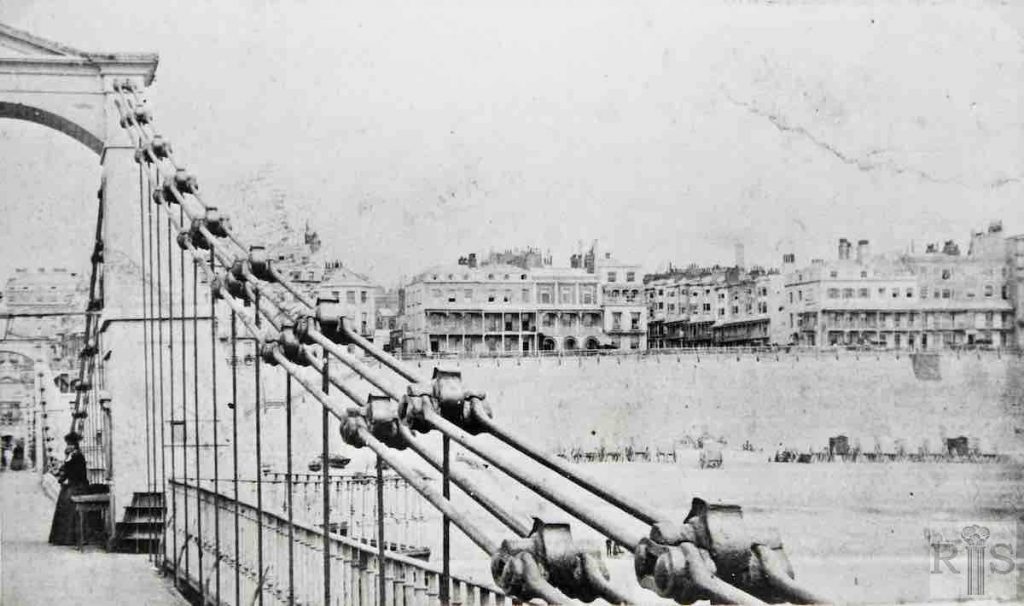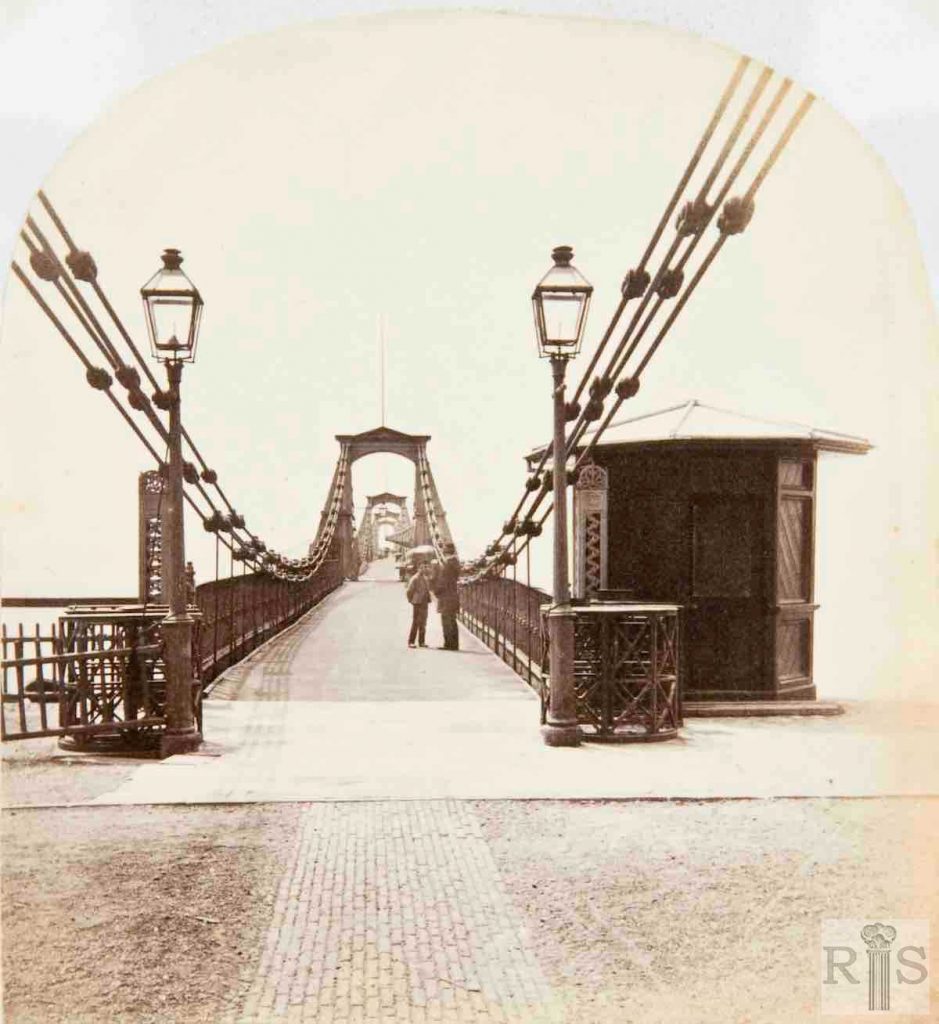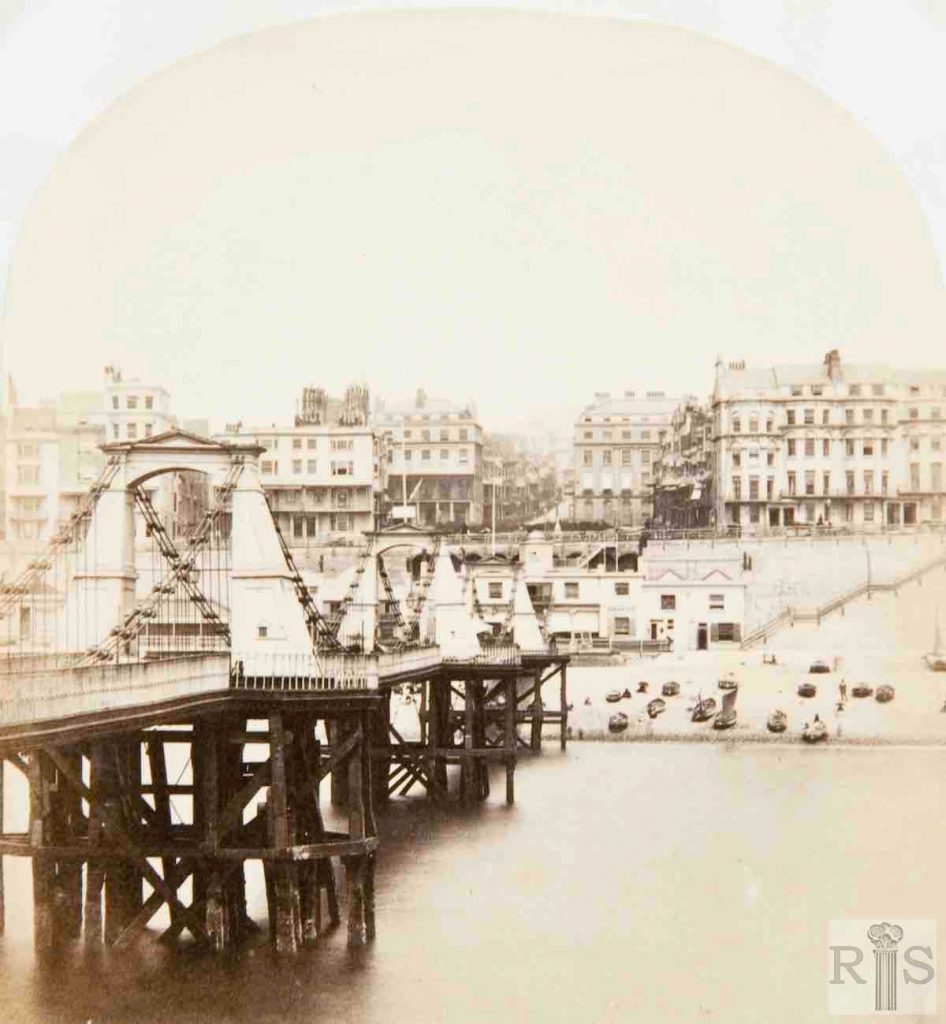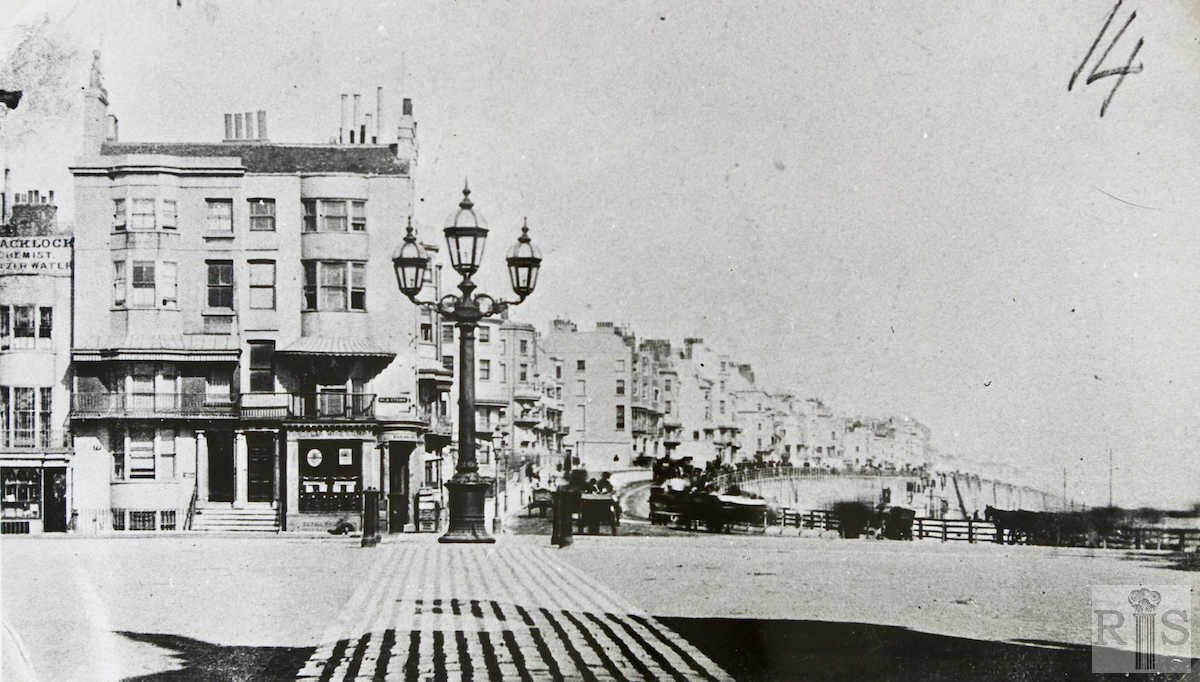
between Grand Junction Road and Lower Rock Gardens
James Gray: The amateur snapshot should not of course be in this album as it is of the Old Steine, but it is a handy space filler. Taken on 3 September 1933, it shows the leaders of the London – Brighton Walk approaching the Aquarium finish line. jgc_03_141
2020: Harry Ramsden’s ‘famous’ Fish & Chip Restaurant is now situated on the corner of Marine Parade and the Old Steine.
James Gray: This photograph must date from before 1872 because it affords a view of the Chain Pier Esplanade. There is no sign of the Aquarium, which was built on this site in 1871. Note how narrow Marine Parade was at this period, as it was not until the Aquarium was being built that opportunity was taken of widening it at the western end by a curve carried over arches. The two houses, 33 and 34, Old Steine, were then occupied as lodging houses, with a Wine Office on the ground floor of 34. The cobbled stone crossing is on exactly the site of the present (1956) Zebra Crossing. jgc_04_049
James Gray: [See caption for jgc_04_049 above.] jgc_04_050
2020: Images jgc_04_049 and 050 are virtually identical, the first being a black and white copy of the sepia original here. The address of the former Nos 33 and 34 Old Steine has been changed to 1-4 Marine Parade. (Photographer: David Sears)
James Gray: This interesting photograph shows an area of the beach which is now covered by the Palace Pier. The Aquarium sea wall built some 10 years earlier still preserves its new appearance. jgc_04_054
2020: The Palace Pier obscures the view of the aquarium and beach levels have also changed. The clock tower was demolished in 1928. (Photographer: David Sears)
James Gray: [Top row left] Another view. jgc_04_141
James Gray: [Top row right] No comment. jgc_04_136
James Gray: [2nd row left] Exact period unknown. Obviously after 1911 and probably about the time of the 1914-18 War as there are few young men to be seen. Additional Information: Poster shows concert by Solomon on Saturday July 31 – this is 1915. jgc_04_096
James Gray: [2nd row right} [See caption for jgc_04_129 above.] jgc_04_130
James Gray: [3rd row left] No comment. jgc_04_134
James Gray: [3rd row right] There are several clues to the age of this photograph. The electric lamp standard, the Chain Pier, Madeira Terrace partly built, and the hoarding masking the skeleton of the new Palace Pier limit the period between the years mentioned [1893-1896]. jgc_04_132
2020: The old images (jgc_04_136 and 141) look north-east from Madeira Drive, across the entrance to the Aquarium, to the hotels on the other side of Marine Parade. The modern image shows the entrance to the new Aquarium which opened in 1929, now trading as Sea Life Brighton. The streets are empty and the attraction itself is closed due to the coronavirus pandemic. (Photographer: David Sears)
James Gray: Photograph by Edward Fox dating from about 1875. This enlargement is merely to bring out the detail of the photograph in the following view. The view is from the corner of Old Steine and some of the side streets such as Manchester Street and Charles Street can be picked out, but where is Steine Street? The narrow entrance must be hidden from view behind the horse and cab. jgc_05_003
James Gray: The original of the previous photograph. jgc_05_004
2020: Gray’s images are identical, the first being a black and white print of the sepia original. They are two of several images of this corner of the Old Steine with Marine Parade, just across from the entrance to the Aquarium. This updated photograph was taken from the Old Steine, slightly to the left of the original location. The building on the corner of Marine Parade is now occupied by Harry Ramsden’s fish and chip restaurant. (Photographer: David Sears)
James Gray: This very clear photograph, also by Mr. A.H. Fry, shows the downward gradient of Volk’s railway to take the line under the Pier. Note Snelling’s Bazaar and the Camera Obscura. jgc_05_081
2020: Sadly, after suffering damage from a series of violent storms, the structure collapsed into the sea in December 1896 and today nothing is visible in the sea or on land.
James Gray: This photograph is much older [than jgc_05_130 and 131], dating from the 1880s or early 1890s. Volk’s Railway line is seen descending to pass under the Chain Pier which was destroyed in December 1896, so it dates from before then. A good view of the houses in Marine Parade and a few in New Steine. jgc_05_132
2020: This view was taken from the Palace Pier and is more or less in line with the original photograph. Many of the buildings in the original survive although the photograph is dominated by blocks of flats built in the 1960s and 1970s. (Photographer: Simon Cooper)
James Gray: Construction of the Madeira Terrace in progress. The easternmost section of this terrace, together with the Shelter Hall and Lift, had been opened in 1890. The extension westwards of the Terrace to a point just short of the old Aquarium was completed in 1897. In the following year, 1898, this section of Madeira Drive was widened from 60 to 100 feet. jgc_05_137
James Gray: All one can say about this photograph is that it was taken in the 1880s. The wood and iron railings, the state of the West Pier and the rails of Volk’s Railway, are proof of this. This photograph gives another good view of how, in those days, the sea came much higher up the beach than it does today. jgc_05_147
James Gray: This view was taken several years later, [than jgc_060_020] at some time between 1884 and 1890. jgc_06_021
2020: The general view is recognisable, though many of the buildings have changed. The Chain Pier has been demolished and replaced by the Palace Pier. In the distance is the latest visitor attraction, the i360. (Photographer: Simon Cooper)
James Gray: This view dates from May 1937, at the time of the Coronation of King George VI, at the Aquarium terminus. Note the quiet appearance of the roadways. This was a period of quick, reliable and cheap public transport, with few cars and lorries to create the traffic jams from which we suffer today. jgc_10_069
James Gray: Disappointed crowds around the Aquarium in the rain on August Bank Holiday, 7 August 1922. Note the long line of motor coaches stretching far into the distance. These then shared with the Railway the task of bringing down to Brighton the hordes of day-trippers for which the town was then famous. jgc_05_157
2020: No-one would contemplate walking along this busy road today. (Photographer: Simon Cooper)
James Gray: Four-in-hand wagonette, at rest and facing west, outside Chain Pier Cottages period 1893-96. jgc_05_160
James Gray: [Above is] yet another of the many photographs of the Chain Pier Cottages, taken in the 1920s. jgc_06_101
2020: The Chain Pier Cottages were removed in 1927. This new image is close to where they stood. (Photographer: Simon Cooper)
James Gray: Bath Chair and attendant on Madeira Drive adjoining the Chain Pier, about 1890. The lady passenger was Madame Sidney Pratten, a well known guitarist. jgc_05_059
James Gray: This photograph is said to date from 1890. jgc_05_139 Additional Information: Carriage and groom, with two ladies seated, in front of Chain Pier.
James Gray: Two photographs [jgc_06_009 and 010] of what is probably the busiest corner in Brighton. This one [on the right] is of uncertain age but looks as if it were taken in the late 1930s. jgc_06_009
James Gray: This view dates from 1922 when there was little traffic about and one could cross the street in safety. Additional Information: Ye Old Steine Restaurant: the corner restaurant was occupied by Sam Isaacs at the time of this photograph. jgc_06_010
2020: The building on the corner of Old Steine and Marine Parade is now occupied by Harry Ramsden’s fish and chip restaurant. The adjacent block was built in 1970 on the site of the old Albemarle Hotel, 11 years after it was demolished in 1959. (Photographer: David Sears)
James Gray: 5, 6 and 7 Marine Parade, for many years known as the Albermarle Hotel. It was founded at No 7 during the 1850s and is listed as such in Folthorpe’s Brighton Directory of 1859. For many years the other two premises were lodging houses, but they were absorbed into the Albermarle in the 1890s. When the property was sold for redevelopment, Brighton Corporation consulted the Regency Society as No 7 had been listed by the Ministry of Housing and Local Government as a building of Special Architectural Interest. It was not felt that the quality of the building was good enough to justify opposition to its demolition, so down it is to come. The photograph was taken in January 1958, when the premises were awaiting demolition. jgc_06_011
2020: The Albemarle (note correct spelling) was finally demolished in 1959. The site of the former hotel then remained empty for 11 years before the present block of flats was erected. The distinctive buildings at the far end of Steine Street to its left (west) and on St. James’s Street, can still be seen in the modern image.
James Gray: This photograph of 1911 speaks for itself! Additional Information: The Albermarle Hotel illuminated to celebrate the Coronation of King George V. jgc_06_012
2020: Gray’s blurry night-time image shows the Albemarle Hotel well lit-up, as were, doubtless, many of its customers celebrating the coronation of King George V in June 1911.
James Gray: Work at last starting on the building of flats, which are to arise on the site of an old Albermarle Hotel, a photograph of which is on the preceding page [see jgc_06_012 above]. After the hotel was demolished in 1959 the site was empty for no less than eleven years. jgc_06_013
2020: Gray’s image is looking north-west from the south side of Marine Parade. The replacement block is also known as the The Albemarle, with Bar Revenge on the ground floor. (Photographer: David Sears)
James Gray: Rebuilding of the Aquarium Garage in progress after many years of inactivity. Photographs of buildings previously on this site [jgc_06_024 and 027] are seen on other pages. Both these photographs [see also jgc_06_013 above] were taken in January 1970. Additional Information: The garage was, in turn, demolished and is now the site of the Van Alen flats. jgc_06_014
James Gray: 9 Marine Parade, in 1897. This was soon after Parsons and Sons had left but before it first became a hotel in 1901. Additional Information: Beeston Cycles and Motor Cycles, with cyclists. jgc_06_015
2020: The single floor front extension helps to identify the building located at the corner of 9 Marine Parade and Charles Street. At the time Gray’s photograph was taken, it was still the home of the Brighton Cycle and Motor Company. (Photographer: David Sears)
James Gray: 9 Marine Parade was originally a private house, then a library and, from the 1850s onward, was occupied by Parsons and Sons, Auctioneers and Valuers, for nearly half a century. In 1910 it became a hotel, first the Carlington and then in 1908, the Arlington. It was demolished and rebuilt in its present form in 1935. The hotel is seen behind the group of people crossing the road. jgc_06_017
2020: Street directories show that 9 Marine Parade became Faulkner’s Hotel in 1901, renamed as the Arlington Hotel in 1906. This is the view from the Aquarium roundabout looking east along Marine Parade today. To the far left of the picture, the hotel building has been replaced by the Charles Street Tap. The Marine Hotel, with its curved window arches, has been renamed Marine House. On the far right of this image are now the sail-like awnings of the Madeira Harvester Pub. (Photographer: David Sears)
James Gray: On the right a view of the terrace in 1926, with Southdown buses lined on Madeira Drive. jgc_04_155
2020: This image shows the ground level terraces of the old aquarium shortly before demolition started in the following year (see jgc_04_176, jgc_04_182 and jgc_04_183, for instance). Marine Parade stretches east into the distances. The buses on Madeira Drive, to the right (south), and their routes are also described in the caption to image jgc_04_170. (Photographer: David Sears)
James Gray: 9 Marine Parade was originally a private house, then a library and, from the 1850s onward, was occupied by Parsons and Sons, Auctioneers and Valuers, for nearly half a century. In 1910 it became a hotel, first the Carlington and then in 1908, the Arlington. It was demolished and rebuilt in its present form in 1935. jgc_06_018
James Gray: Here is a photograph which gives food for thought. Obviously, it shows Marine Parade and the Aquarium Clock Tower but what was the reason for the continuous wooden planking? My theory is that this was erected during the building of the Aquarium to protect bystanders from falling the considerable distance into the area of the entrance steps, many feet below. If I am right, the period would be 1871-2. The lamppost stands at the corner of Charles Street, and the advertisement is for W. Gilburd & Son, wine, spirit, ale and porter merchants who were also the proprietors of the Pier Hotel. Additional Information: ©Philippe Garner. jgc_06_019
James Gray: It is a pity that these six charming cameos, taken from the Chain Pier and looking east and west, are so faded as they show so much of interest. [See images starting at jgc_05_033 on the Chain Pier page.] Another view of the seafront and King’s Road. jgc_05_036
James Gray: View looking west. jgc_05_037
James Gray: Copies of two old, but fairly clear, photographs [see also jgc_06_021] of the eastern marine frontage. This photograph, obviously taken from the Chain Pier, almost certainly dates from 1872, because the Pier Esplanade has gone and the new low sea wall, built in 1871, is there. There are indications that the Aquarium was being built and this was opened later in 1872. The two lateral streets seen here are Camelford Street and Margaret Street. Additional Information: ©Philippe Garner. jgc_06_020
James Gray: Two photographs of the same event, on the same day, but by separate photographers. The event was Hospital Parade on 18 July 1908. Above, the Bentham Road Mission Band of Hope are assembled on Madeira Drive. jgc_06_022
James Gray: An unnamed band is just a little to the east, on the terrace of the old Aquarium. jgc_06_023
James Gray: A view of Marine Parade and Camelford Street in March 1963. jgc_06_027
James Gray: 29 and 30 Marine Parade, at the corner of Camelford Street, about 1916. In 1939, there was a suggestion that these houses and some in Camelford Street should be cleared and the site added to the adjoining garage premises. Accordingly, they and 1/3 Camelford Street were demolished in 1939. On the next page [jgc_06_027 on the far left] can be seen the cleared site in 1963, and at present (1977) it looks just the same!! How we progress? jgc_06_024
2020: Montague House on the western corner of Camelford Street and Marine Parade was demolished in 1939 and the site cleared in 1963 to extend the adjacent garage premises. In turn, the garage was demolished in the late 1990s to make way for the Van Alen building which opened to much acclaim in 2001. (Photographer: David Sears)
James Gray: It is hard to date this with accuracy. Certainly it was taken prior to 1880, because in that year the present railings of cast iron and teak have replaced the old oak fence of uprights and cross beams. The house against which the ladder is resting is 38, Marine Parade, on the corner of Wentworth Street. The buildings have not altered much in 80 years apart from the removal of certain balconies and verandas. Additional Information: Horse and carriage. jgc_06_029
2020: Looking west from the corner of Wentworth Street today. The tall bow-fronted building still stands but has been renamed Glenside Court. The view looking east can be seen in jgc_06_047 below. (Photographer: David Sears)
James Gray: In this photograph people are looking over the wooden railings to the Chain Pier Esplanade below. This dates the picture as the Aquarium was built on the site of the esplanade in 1871. Additional Information: Photographs by Edward Fox? jgc_06_035
2020: This updated photograph has been taken slightly further east along Marine Parade. The distinctive building housing the Charles Street Tap (which replaced the Arlington Hotel seen in jgc_06_017 and 018 above) is just out of shot to the left of the modern picture. The window arches of the former Marine Hotel, now Marine House, can still be seen on the far side of Broad Street. The awning on the right belongs to the Harvester Pub, built on top of the ‘new’ aquarium which opened in 1929. (Photographer: David Sears)
James Gray: Two more [see also jgc_06_037 on the Marine Parade (2) page] of the many photographs of this then fashionable area in mid-Victorian times, about 1870. Looking west, from the bottom of Lower Rock Gardens. The range of buildings, with pillars and balconies, are 46 to 49 Marine Parade, between Rock Place and Lower Rock Gardens. jgc_06_036
James Gray: Looking west along a quiet and deserted Marine Parade. In the distance, and at a lower level, can be seen Brighton Aquarium, opened in 1872, which suggests this is yet another of the 1870s photographs of this area. No signs yet of Volk’s railway, opened in 1883. jgc_06_044
2020: The Chain Pier has gone and the once quiet road is now busy with traffic. (Photographer: Simon Cooper)
James Gray: Hanover House Hotel, 31-34 Marine Parade. jgc_06_045
2020: The building occupying the block between Camelford Street and Margaret Street now houses Legends Hotel and Bar. The main architectural change is to the roof where the central dormer windows, just visible in the original image, have been extended along the length of the building. The drainpipe down the front remains in place. (Photographer: David Sears)
James Gray: Field’s Pier Hotel, 10 Marine Parade. jgc_06_046
2020: This hotel on the eastern corner of Charles Street was rebuilt in 2015 and now trades as Patterns Bar. The colourful venue now offers a ‘safe space for Brighton’s underground club culture’ and other small musical events. (Photographer: David Sears)
James Gray: Madeira Hotel, 21-23 Marine Parade. The Pier and Madeira Hotels remain, but Hanover House is now separately occupied as dwellings and flats. jgc_06_047
2020: The rather faded image of 1910 shows Marine Parade looking east from Madeira Place to Margaret Street. The New Madeira Hotel stands on the site of its namesake. (Photographer: David Sears)
James Gray: From Beacon House, corner of Charlotte Street to the Royal Crescent Hotel. jgc_06_048
James Gray: The furnished house, 70 Marine Parade, at the corner of Charlotte Street in 1881 or 1882. These were the two years during which the photographer G Schulz was at 44 Ship Street, Brighton. jgc_06_049
2020: Images jgc_06_048 and 049 and, on the Marine Parade (2) page, jgc_06_043, show the (then) newly built red-brick Beacon House on the eastern corner of Charlotte Street and Marine Parade in the 1880-1890s. An earlier image, jgc_06_042 (also on the Marine Parade (2) page), taken in the 1870s shows it in its original form. Today it lives on as The Lanes Hotel. The figure in the white tuxedo on the first floor balcony is a rather disconcerting cut-out. (Photographer: David Sears)
James Gray: No comment. jgc_06_062
James Gray: One of the few photographs in existence which shows Marine Parade before the construction of Madeira Road. The concrete wall of the Parade, built in the 1830s, had been backed by earth from the beach upwards. In rough weather the sea washed right up to the base of the cliff. The iron railings at the kerbside had been erected only a year or two earlier and were still without their diagonal cross members. In the distance can be seen the West Pier under construction. jgc_06_070
James Gray: Looking into Old Steine, from the curve of Marine Parade, again from the 1860s. Note the low building just to the right of the Royal Albion Hotel. In the original photograph the name Thomas Strong plumber and painter can be discerned. His premises were at 12, Pool Valley until 1869 when there was a clearance before the erection of Brill’s Baths. This important information has been lost to sight in the copying. Additional Information: Photographer: Philippe Garner. jgc_06_077
2019: The view from Marine Parade looking south west towards Old Steine. The Royal Albion Hotel on the left and Royal York Hotel (now the YHA Brighton) on the right are still there.
James Gray: Two more photographic copies [see also jgc_06_082 on the Belgrave Place page] of drawings by William Alfred Delamotte, dating from 1858. This view is of the westerly end of the Parade from near Old Steine to Broad Street. Notable buildings ALBERMARLE (later Hotel) and PIER HOTEL. jgc_06_081
James Gray: These photographs [see also jgc_04_008 on the Brighton Central Seafront: images on the beach (2) page] are not as old as their faded appearance may suggest. As both the Hotel Metropole and the Chain Pier are shown, they must date from between 1891 and 1896. Judging by the elevation they must certainly have been taken from the skeleton of the Palace Pier. jgc_04_009
James Gray: It is a pity that these six images from charming cameos, taken from the Chain Pier and looking east and west, are so faded as they show so much of interest. [See images starting at jgc_05_033 on the Chain Pier page.] For example in this photograph can be seen the old entrance to the Toll House but with the wall of Madeira Drive built out seawards in front of it. Also the large array of building material suggest that the Aquarium was being built. jgc_05_035
James Gray: No comment. jgc_05_052, 053 and 056
James Gray: Two photographs of the Pier, dating from 1871 or 1872. jgc_05_057 and 058
